Archive for the ‘Featured’ Category
Friday, June 3rd, 2016
By Carolyn Yeager
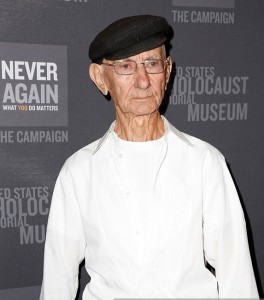
Joshua Kaufman at the USHMM 2015 Los Angeles Dinner in Beverly Hills.
Just like Elie Wiesel, Joshua Kaufman’s claimed Auschwitz number doesn’t fit his own story of how and when he could have been assigned it.
At the end of my previous article on Kaufman, I asked readers to join me in demanding answers from him about his claim to be Auschwitz number 109023. He said to reporters in the courtroom in Detmold, Germany, as quoted by NBC News [See Comment #1 below]:
“Can you imagine working in a crematorium, when you are only 15 years old? I had to break the bones of the dead to get them untangled … I am not Joshua Kaufman, I am number 109023.”
I heard nothing from Kaufman, but I did hear from Carlo Mattogno, the accomplished Italian revisionist. Carlo looked up the numbers and helpfully sent me the following information (my bolding):
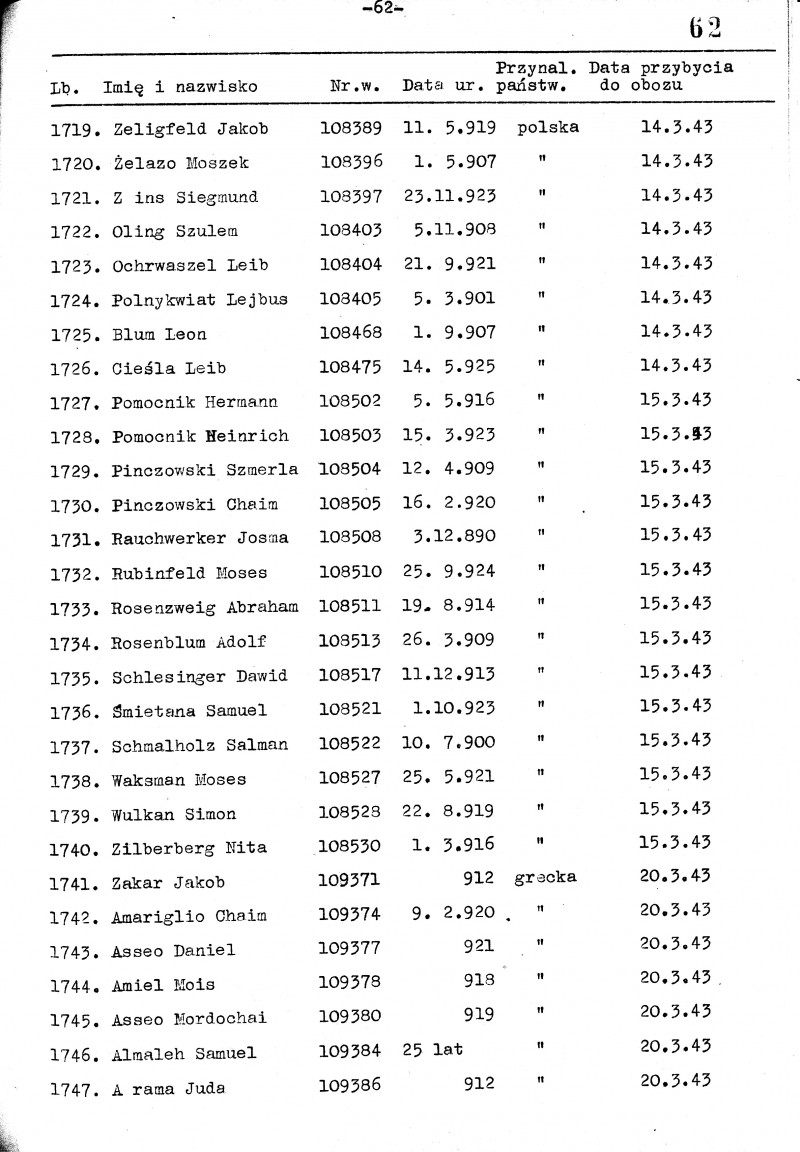
Source: Archiwum Głównej Komisji Badania Zbrodni Przeciwko Narodowi Polskiemu – Instytutu Pamieci Narodowej, Warsaw: AGK, NTN, 156, p. 66
A list of inmates compiled by the judge Jan Sehn reports the names of the inmates of a transport that arrived at Birkenau on March 15, 1943. The last number assigned was 108530.
The next number in this list is 109371 – a certain Jakob Zakar – who was part of a transport from Greece which arrived in Auschwitz on March 20, 1943.
This means that the number 109023 was assigned between these two dates.
According to Danuta Czech’s Kalendarium [a source used as official Auschwitz data -cy] the number 109023 was assigned on March 18th, 1943 to a group of 465 male (numbers from 108763 to 109227) and 114 female prisoners (they received the numbers 38469 to 38582) sent to Auschwitz from the SiPo [Security Police] Radom, in the General Gouvernment (now Poland).
Mattogno concludes from this that Kaufman’s story lacks either truthfulness or exact dates. The dates, however, are confirmed by the Kalendarium of Danuta Czech and by the judge Jan Sehn.
* * *
Since Kaufman is Hungarian, and came to Auschwitz from the Debrecen Ghetto in Hungary, which didn’t exist until 1944 (from mid-May to mid-June), he could not possibly be the person who was registered with the number 109023 on March 18, 1943. Did Kaufman just pick that number out of thin air? Did he perhaps know of the person who had that number and knew he would not say anything if he (Kaufman) used it? Is Kaufman going to deny he ever said that? If 109023 is not his number, what is? He has not shown his arm the way all those who have a tattoo are willing to do. Kaufman is like Elie Wiesel in that he never seems to take off his jacket.
So let’s see – gosh, do you think he could be making it all up? (blink, blink) How could he have the nerve to do such a nervy thing, is how most people respond. They can’t believe anyone would be so reckless and therefore try to “fill in” with some reasons that makes sense to them. Well, these holocaust surlievers get treated with such incredible deference that it encourages them to emerge out of the woodwork and tell stories out of whole cloth. They actually do it all the time, and get well-compensated for it. Only in a few cases do they get caught in a big enough way that it stops them. Plus, in Kaufman’s mind he’s doing it for Israel, for the benefit of the Jews of the world, and for “Never Again.” He’s going to die soon, so wants to help out the cause before he’s gone. He believes he’s on the side of justice. What are a few lies compared to that?
Media, which is more powerful than one single nation or the judges in a courtroom, is on his side. Reporters and editors of major news outlets present what he says to the public as believable … as news! They are the biggest criminals of all, in my opinion. Their crime is writing and encouraging false news; helping to railroad an innocent man like Reinhold Hanning by reporting lurid lies spoken by surlievers that they have to know cannot be true. It is NBC News and Joshua Kaufman who should be brought up on charges rather than Reinhold Hanning, who is innocent of any specific wrongdoing. But the law is not written that way – the law is written according to political power. Therefore, only political pressure can change it.
How about a lot of you write to NBC News and attach the NBC article above about Kaufman at Hanning’s trial in Detmold (the final judgement comes on June 9th), and inform them that Kaufman is lying about his number 109023. Include the evidence from Carlo Mattogno. Tell them they need to write an apology for printing information without checking its accuracy. NBC is the most far left of the network news outlets and they make it difficult to contact them. This is what I found:
To report an error or comment on NBCNews.com, please email [email protected]
The reporters are Andy Eckardt and Carlo Angerer, but no email addresses are given, only Twitter accounts.
https://twitter.com/@ameckardt – he has Kaufman’s picture on his page. Please visit him if you have a Twitter account.
https://twitter.com/@carloangerer – also on Facebook: https://www.facebook.com/carloangerer
I’m still asking Joshua Kaufman or one of his daughters to answer for him. He demanded answers from Reinhold Hanning; he needs to give some of his own.
1 Comment
Category Featured | Tags: Tags: Andy Eckardt, Carlo Angerer, Carlo Mattogno, Danuta Czech, Debrecen Ghetto, Jan Sehn, Joshua Kaufman, NBC News,
Social Networks: Facebook, Twitter, Google Bookmarks, del.icio.us, StumbleUpon, Digg, Reddit, Posterous.
Wednesday, June 1st, 2016
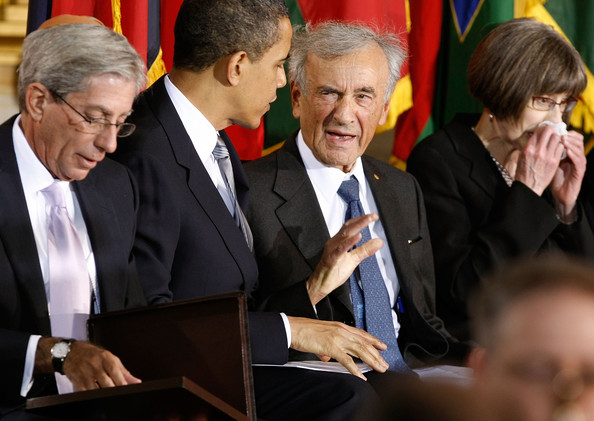
Elie Wiesel shows his ugly side in an unguarded moment during a “Holocaust Remembrance Day” ceremony at the U.S. Capitol Rotunda in 2009.
By Carolyn Yeager
TIFFANY YEP, LINKING TO a Google page of that name, wrote a comment to my article “Elie admits he doesn’t have the tattoo A7713.” I thought it called for more attention than a comment usually gets so I’ve made an article out of it. Tiffany is apparently in high school, and I can say the generation gap between us is pretty vast since I don’t understand her Google page at all. (I’m sure I’m not supposed to.) The comment, however, is easy to understand and I’ve seen quite a few like it. However Tiffany, being pretty bright, adds a slight twist. She says that Elie Wiesel’s version of what took place in the concentration camps, even if he made it all up, is still more valuable as a teaching aid than are more forgiving stories because he portrays the “horror” the Jews felt. I noticed on Yep’s Photo page a couple of holocaust horror pictures – one a very dishonest composite with Dr. Mengele, taken from an exhibit. Here’s her comment to me, all packed into one paragraph:
Tattoos can easily fade over the course of many decades. Even if he is not truly a survivor, his book “Night” has done wonders to teach people what went on in concentration camps. All you hear are tales of bravery and resistance and love from books about the Holocaust. These books betray the true horror of the Holocaust. Many of the survivors did not speak of what if (sic) actually felt like to be imprisoned in Auschwitz or Monowitz. Wiesels’ novel, real or not, accurately displays the anger and helplessness felt by the Jews in Germany and Poland and in other parts of Europe. Even if you are right and he is conning people, he still deserves that Nobel Peace Price (sic). Millions of youths from around the world have learned from “Night”, and in order to mot (sic) repeat history, we must learn the history. he could also have removed the tattoo, since his entire life does not center solely on his novels, and he can possibly be triggered when looking at the tattoo. If you haven’t picked up what I’ve been saying in this essay, basically a) you call him an idiot if he removed the tattoo because he wrote the books-he has his own feelings outside of proving he was at Auschwitz, and he may be triggered by the tattoo and the memories behind it, and b) even if he has never set foot in Auschwitz, his book has still done wonders to educate people on the honest horror and devastation in the concentration camps, versus the stories of faith and love and selflessness of people who managed to avoid it. And answer this question-if he was never in a concentration camp, how on earth was he able to depict them so accurately?
Let’s take the first sentence, Tattoos can easily fade over the course of many decades.
Yes, they can fade, but do not become invisible. “Most tattoo inks will fade over time but never fade away completely. The edges of the tattoo usually become less defined with time,” says the sharpologist. Tattoos are applied to the Dermis, which is underneath the Epidermis (top layer of skin). The Epidermis replenishes itself by forming new skin cells, but the Dermis does not. Tattoos are permanent, although will experience some fading over decades, according to this site.
This page should convince Tiffany that her theory of Wiesel’s vanishing tattoo cannot be right. Please notice the pictures of Auschwitz survivors who are more than willing to show off their tattoos. There is Samuel Bradin (now 86), Henry Flescher (now 92), Leo Zisman (now 84), and Paul Argiewicz (died in Dec. 2013 at age 88). Notice that each of their tattoos is somewhat faded but still very visible.
Elie Wiesel is now 87, in the same age group, but he does not “show” his tattoo because he doesn’t have one. If he had one, it would be just as visible as those of his contemporaries. Wiesel stands out at this event where he was the main speaker as being the only Auschwitz survivor who doesn’t pull up his sleeve. No one would dare ask him to, either. To any but the willfully blind, this behavior (along with photos of his bare arm) proves that Wiesel never had an Auschwitz tattoo.
The next amazing statement Tiffany makes is “Even if he is not truly a survivor, his book “Night” has done wonders to teach people what went on in concentration camps.”
So where did he learn what went on in concentration camps if he had not been in even one of them? I doubt Tiffany is aware that Wiesel gets angry when people suggest his book is a novel, not his faithful testimony. But what Tiffany is actually saying is that people who weren’t there can teach us what it was like to be there just as well or better than people who were there. Read that sentence again. The reasoning goes that those who make it up, who invent stories out of whole cloth, can write more interesting books than those who tell it as it actually was. Does Tiffany likes the gory stuff because that is the focus in her school holocaust lessons?
She’s saying that Wiesel’s novel, whether real or not, is still accurate in it’s depiction of how the Jews felt. No! What is not real cannot be called accurate. Wiesel know Jews, there’s no doubt about that. He describes Jews as he knows them, inside a concentration camp of his own invention, creating peculiar Jewish conversations. When the reader can relate to the characters, and live the event and feel the feelings vicariously, that is a successful novel. But to be a testimony, it has to have actually happened. Tiffany doesn’t care about such distinctions; she wouldn’t bat an eyelash over Wiesel’s own admission that what he writes isn’t true. He has famously admitted in various versions:
“In literature, certain things are true though they didn’t happen, while others are not, even if they did.”
He’s confessing that he’s writing “literature”, not testimony – literature being imagination and story-telling, testimony being a faithful account of what one has observed. And Tiffany goes along with that because she approves of super-charging the story-line to better get the point across.
Finally, she says. even if he is conning people, he still deserves that Nobel Peace Prize. For conning people?! If the Holocaust is a con (not just by Wiesel), then it is not history. Therefore, there has to be some reason that it is pretending to be history. If we learn not to repeat what never happened anyway, we are learning nothing. What should we be learning instead? We should be learning why and by whom this Holocaust con has been brought to us, that’s what.
When invention and 2nd-3rd hand information are offered in place of faithful testimony, it is then a lie. A LIE cannot be accurate. Tiffany would do well to try to understand the moral distinction. All her nattering about Wiesel’s feelings is meaningless, since she doesn’t know him or his feelings. Rather than imagining what he feels, she would do well to read Holocaust High Priest by Warren B. Routledge and learn something about the real Elie Wiesel.
Wiesel has also done nothing for peace. He is unqualifiedly pro-Israel and Israel is an aggressor-nation ever since it was allowed under strict rules in 1948. It has broken every rule and also sureptitiously developed powerful nuclear weapons. How does the promotion of the false holocaust story bring about peace in the world? Israel and Jewish surlievers collect ever-increasing amounts of money from Germany, along with nuclear submarines, and also huge amounts of money to buy armaments from the U.S. So much is given to Israel there is not much left for anyone else.
At the end of her comment, Tiffany does me a favor by asking me to: Answer this question-if he was never in a concentration camp, how on earth was he able to depict them so accurately?
Oh, so easy. He didn’t! That is what most of the articles on this website are about – how his stories about Auschwitz and Buchenwald don’t fit the official narrative – and contain numerous inner and outer inconsistencies and contradictions. There is nothing accurate about his descriptions (or lack thereof) of Auschwitz, Birkenau, Monowitz or Buchenwald. He waited 10 years to write his “testimony” in order to have other reports to model his on, not because of the fatuous reasons he gives—and he still got most of it wrong! No, clearly, Tiffany doesn’t have any idea what is accurate when it come to the “Holocaust” or to Elie Wiesel, but I will venture to say she likes the story the way Wiesel tells it because it makes her feel good about herself – she is one of those who will make the world a better place.
So now Tiffany, how about answering a question for me: How on earth can you believe something you know so little about?
By what inner workings have you accepted what you were taught in school without applying any critical analysis? Was there a critical element involved in your Holocaust Study unit? Were students comfortable in asking questions of a critical nature? Do you consider yourself well-educated about Elie Wiesel and the “Holocaust?” Will you even ask these questions of yourself?
Maybe someday you will. I’m glad you let me know that you have read this site. I invite you to read and comment more, as I would be more than happy to get into a dialogue with you.
8 Comments
Category Featured | Tags: Tags: Elie Wiesel, Night, Tiffany Yep,
Social Networks: Facebook, Twitter, Google Bookmarks, del.icio.us, StumbleUpon, Digg, Reddit, Posterous.
Sunday, May 22nd, 2016
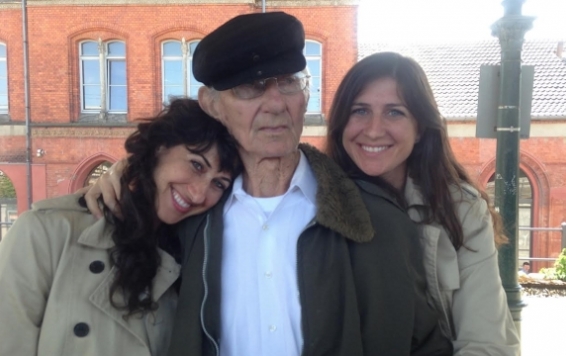
Joshua Kaufman poses with his daughters Alexandra (left) and Rachel in front of the Chabad building in Berlin, after leaving the show-trial in Detmold. (photo from Jewish Journal)
By Carolyn Yeager
That’s not asking too much. He burst on the scene (with the help of Bild news organization) of what is already a show-trial in Detmold, Germany and made it even showier. He sought attention for himself.
He is quoted by NBC News as proclaiming in the courtroom, referring to Auschwitz
“Can you imagine working in a crematorium, when you are only 15 years old? I had to break the bones of the dead to get them untangled … I am not Joshua Kaufman, I am number 109023.”
[Note: It has been discovered, on 7-5-16, that the number Kaufman gave to NBC when speaking about Auschwitz was his Dachau prisoner number. Keep that in mind as you read this article.]
I think, under the circumstances, this statement requires him to tell us if he has this number tattooed on his arm. He sought publicity for his story of being a victim of Auschwitz – no one dragged him into that courtroom as they dragged Reinhold Hanning, the defendant. He can’t selectively say what he wants and hold back what he doesn’t want to say. Plus most of his fellow Auschwitz deportees willingly show their tattoo – those that have one, that is.
I have explained elsewhere that according to the bits and pieces Joshua Kaufman has thrown out there (not in any chronological order, by the way), he cannot have had the Auschwitz number 109023. According to the Auschwitz-Birkenau Museum web site, as a Hungarian Jew arriving at Birkenau in 1944, his number would have been preceded by an ‘A’ followed by a number no higher than 20,000. The number he gives is over 100,000. Because of this discrepancy, which he himself originated, he is responsible for answering how he came up with this number.
A second problem with this statement is that it can be shown he was 16 years old when he would have been in Auschwitz in 1944. Yet he even says he was 15 at Dachau, in 1945. It appears he has chosen the age of 15 for his victim story because it has a better ring to it than does sixteen.
A Media Creation
The media won’t ask such a question or bring up any discrepancies. The Joshua Kaufman story is a media creation. Beginning with the Daily Mail UK‘s trumped-up January 2015 story about a reunion with his American “liberator,” then moving on to Germany’s Bild and it’s before-and-after arrival video, plus the US’s NBC News coverage in the courtroom with Kaufman, it is media creating the news. Yet with these three major news outlets covering the man’s story, we still know practically nothing of substance about Kaufman. All they give us are a few outrageous lies (like the one quoted above), and ‘human interest’ profiles.

A Bild photographer took this picture of Kaufman’s home and work van when a team visited him in California before he even left for Germany to crash the show-trial of Reinhold Hanning. Note Kaufman walking toward his front door.
Here are some things I’ve learned about him from carefully scanning the news articles:
1. He comes from Hungary, born in 1928.
2. He was a “survivor” of the Debrecen ghetto.
3. He was deported to Auschwitz (probably in 1944), then worked in 3 smaller camps, ending the war in Dachau where he was liberated on April 30, 1945.
4. He moved to Israel at an unknown date after the war, stayed there for 25 years (some sources say 30 years) and served in the IDF during two wars in 1967 and 1973, then moved to the United States before 1975.
5. He married at age 47, which would have been in 1975, and had a family of four daughters.
6. He worked as an independent plumber in California.
7. He never talked about his holocaust experience until recently because [he said] he felt guilty about throwing fellow Jews into cement mixers. He’s talking about it now because he says, “In ten years’ time, there will probably be no one left who survived it.”
So let’s start with number one and two:
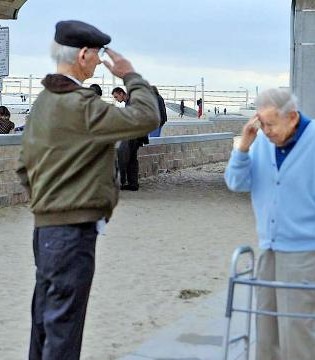
In this cropped photo from the Daily Mail picture layout in January 2015, we can see Kaufman is wearing the exact same clothes he wore in May 2016 at the trial in Detmold, and in Berlin, above.
Kaufman says he is 88 years old in May 2016 which gives him a birth date of 1928. It was his “liberator” Daniel Gillespie (in photo at left) who identified Kaufman to the Daily Mail as a Hungarian Jew. Bild reinforces that by writing that he was a survivor of the Debrecen ghetto:
Kaufman survived the Debrecen ghetto (Hungary). He also survived the Auschwitz and Dachau concentration camps. In Dachau, he was freed on 30 April 1945. Following his liberation, he lived in Israel for 25 years. Kaufman: “In the concentration camp, I was no longer a human being, but an animal. Aged 15, I had to carry 50-kilo bags of cement for more than 12 hours a day. Everyone who could not manage that was thrown into the cement mixer.
Does anyone at Bild really think that exhausted workers were thrown into the cement mixer? I doubt it, but not a questioning word is heard. Checking out the Debrecen ghetto, I found this on Wikipedia:
The order to erect a ghetto there was issued on April 28, 1944. They finished building the ghetto walls on May 15. On June 14 all Debrecen Jews were deported to the nearby Serly brickyards. Most of the Debrecen Jews were deported to Auschwitz, arriving there on July 3, 1944.
The Debrecen ghetto was only used for one month before they were deported to Auschwitz. Kaufman, being among them, wouldn’t have arrived until July 3, 1944, and spent only 10 months at various camps. Or, he never left Hungary at all.
Debrecen was liberated by the Soviet Army on 20 October 1944. Some 4,000 Jews of Debrecen and its surroundings survived the war, creating a community of 4,640 in 1946 – the largest in the region. About 400 of those moved to Israel, and many others moved to the west by 1970.
Considering he doesn’t say when he was arrested, or what he did immediately after liberation from Dachau, he could very well be one of the 400 who moved to Israel from Debrecen and then to the United States in the 1970’s. But, in any case, his alleged Auschwitz number doesn’t fit his history, as far as we can know it. More on that in a moment. First I want to include some history of Debrecen, Hungary’s second largest city, from Wikipedia:
Jews were first allowed to settle in Debrecen in 1814, with an initial population count of 118 men within 4 years. Twenty years later, they were allowed to purchase land and homes. By 1919, they consisted 10% of the population (with over 10,000 community members listed) and owned almost half of the large properties in and around the town
In 100 years they went from 0 to 10% of the population, from 118 to 10,000, and owned 50% of the large properties. This is why they were and are resented. The mistake came when they were given the same rights as Hungarians by being allowed to purchase land and homes anywhere. If individual Jews are not wealthy themselves, they get money from Jews who are wealthy, even abroad, and buy up everything they can as their agent. So the Hungarians were glad to get rid of these Jews when they were deported — not to a death camp but to a labor or detention camp.
At that time, in 1944, Kaufman was 16 years old. He has shown pictures of himself in the Bild video in which he appears to be a well-to-do Jew, both before and after his “ordeal.”
More on Kaufman’s history
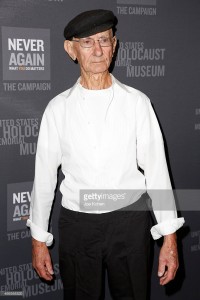
Lookee here. Now-”famous-holocaust-survivor” Joshua Kaufman attends the United States Holocaust Memorial Museum 2015 Los Angeles Dinner at The Beverly Hilton Hotel on March 16, 2015 in Beverly Hills, California. The big layout in the Daily Mail appeared only two months earlier in January 2015. He became a star.
Of numbers 3 through 6, I have no further information than what is stated.
Number 7 tells us that Kaufman’s objective is to help the Jewish case for “The Holocaust,” just like Martin Gray, Elie Wiesel and Paul Argiewicz, and hundreds of others. It’s not about reality but about what’s good for the Jews. Kaufman jumps right into it.
“I lost 100 members of my family, At age 15, I was working in a gas chamber in Auschwitz, dragging out bodies.”
If he became a “sondercommando” working in a gas chamber, he would certainly have been tattooed. Bild newspaper was even told that he had to transport the dead bodies out of the gas chamber with a wheelbarrow. “In Auschwitz, Kaufman had to transport the dead bodies out of the gas chamber with a wheelbarrow. He will talk about this during the trial,” they wrote. A wheelbarrow!? Excuse me, but I have to laugh at that. With 20,000 allegedly gassed per day at that time, you would need a hundred people like him, all bumping into each other with their wheelbarrows!
Then this man Kaufman, who does not answer questions himself, has the gall to make demands on defendant Hanning:
“I would like to hear answers from him. How can you act this inhumanely? How can you live with it? How was he able to happily go home to his family in the evenings? I want him to beg for forgiveness.”
Who is this guy lecturing Germans – showing up at an on-going trial, whether it be right or wrong (it’s wrong, but he’s not trying to right it), with his highly questionable story? What a completely arrogant human being. He goes on:
“They should know what happened to us. In ten years’ time, there will probably be no one left who survived it. That’s why I am talking about it now. For a long time, I did not [talk about it] because I did not feel like a hero. I felt guilty. After all, I had to throw people into the cement mixer, too. Not a single minute passes without my having to think of Auschwitz. I will speak for everyone who did not survive.” (Except it was at Dachau where he says he threw people into the cement mixer.)
He was not a hero! He now thinks people see him that way, after all the movies and books and endless newspaper stories he’s seen over the past 50 years. In the Bild video, he gives himself away by anticipating disbelief in advance, saying: “Everything I did – and nothing is copied from a book and nothing from a movie – everything myself experienced.” That means it’s just the opposite. It was all copied because he only mentions extreme things that never took place in reality. His goal is to exemplify the “Nazis” as evil personified and himself as an innocent survivor of that evil, but what he chooses to say portrays him as just the opposite. As a villain. He “broke the bones” of dead Jews and threw others in a cement mixer!
He volunteered for the ‘gas chamber’ work at Auschwitz
Orit Arfa, a friend of Kaufman’s daughters, wrote a story published in the Jewish Journal of her meeting with the three of them after they left Detmold and came to Berlin. The occasion was a Shabbat (Friday night) dinner at an Orthodox Chabad meeting place. Orit called Joshua “Yehoshua” and said “he had hurt his knee a few weeks earlier but decided he must travel to Germany to seek justice.”
Justice?! For whom? More justice for Jews is all he can mean. She wrote:
He had prepared his words, how he had lugged dead bodies out of Auschwitz gas chambers, pulling them apart as they stuck together during their murder. He was 15 at the time, and volunteering for such gruesome work helped keep him alive.
I get the feeling she read this in the news accounts of the trial, don’t you? Maybe she then asked him about it because she quoted Kaufman as saying:
“It was a way for me to stay alive and to see what was going on around the camp,” Yehoshua related at the Chabad table.
How casually stated! He volunteered to assist in the gassing and cremating of fellow Hungarian Jews in order to stay alive himself! Since he has also said he was sent out to work from Auschwitz, that is not what kept him alive. Big Lie. Another reason was to see what was going on around the camp? Like a tourist? Or a detective? How superficial and unfeeling is this statement. Note he doesn’t say which gas chamber or crematorium he worked in, as if there were only one. Funny no one asked him. But then Orit tells us:
But he seemed more interested in discussing other subjects, like why I wasn’t married. […] He enthused how pleased he was to see me, and how glad they decided to go to Chabad in the end, despite physical and emotional exhaustion from long train rides and legal roller coasters. He looked proudly around the room of Jews singing Shabbat hymns.
So he wants to change the subject, does he? He’s not interested in going into any detail about his stories. This, I think, is the most important sentence I’ve come across, that he didn’t want to discuss it further. He had his “prepared words” and that’s all he had.
After berating Reinhold Hanning for not confessing to what he did not do and did not know, but remaining silent, Joshua Kaufman reveals himself as the most silent of all when it comes to what he doesn’t know and did not do. The Media also remains silent in the face of obvious and important contradictions and impossible claims. Both Kaufman and the Media are engaging in a hypocrisy so entrenched the public barely notices it. But I notice it and I want to know:
How does Kaufman explain his number 109023? Where is his tattoo? I am demanding answers from him. Why don’t you join me.
8 Comments
Category Featured | Tags: Tags: Auschwitz-Birkenau, Bild, Dachau, Daily Mail, Holocaust fraud, Joshua Kaufman, NBC News, Reinhold Hanning,
Social Networks: Facebook, Twitter, Google Bookmarks, del.icio.us, StumbleUpon, Digg, Reddit, Posterous.
Friday, May 13th, 2016
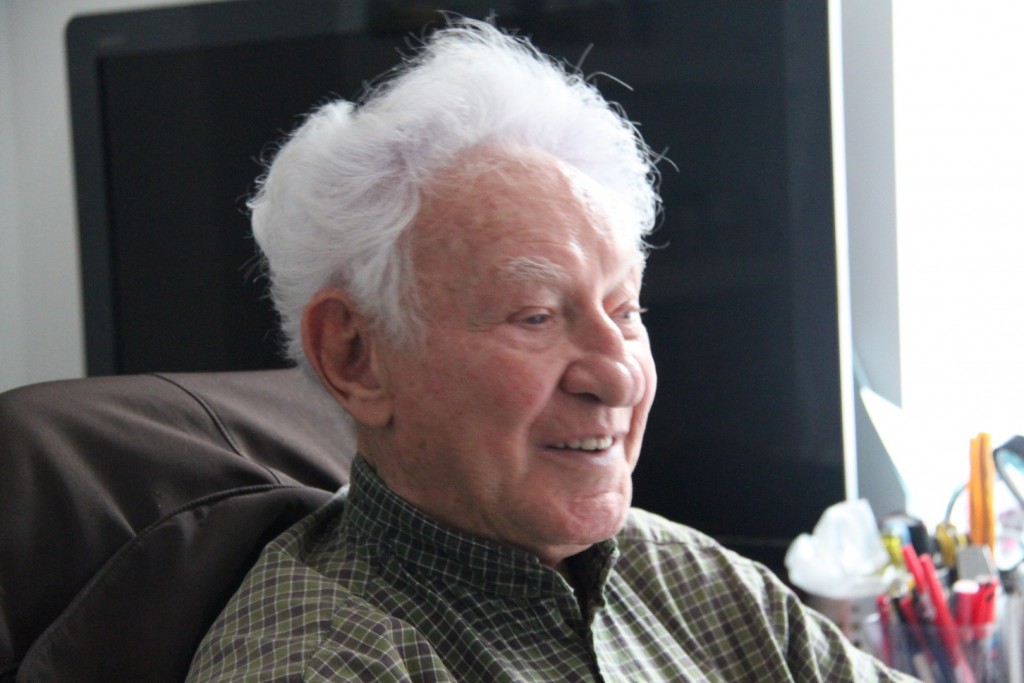
Martin Gray in his old age. Throughout his life as an entrepreneur he wrote a number of books, but his most famous one was written by someone else.
BY CAROLYN YEAGER
When I myself told Gray, the “author”, that he had manifestly never been to, nor escaped from Treblinka, he finally asked, despairingly: “But does it matter?” Wasn’t the only thing that Treblinka did happen, that it be written about, and that some Jews should be shown to have been heroic? -Gitta Sereny, holocaust historian
The French writer Martin Gray, known for his autobiographical book For those I loved, was found dead in the pool of his house in Ciney, Belgium on 25 April 2016 at the age of 93.
So read the newspaper report when his death was announced. But French? Martin Gray was born Mieczysław Grajewski on the 27th of April, 1922 in Warsaw, which made him 17-years old when the Germans and Russians invaded Poland in 1939. Yet in his “autobiographical” book he is only 14 years of age in that year.
September 1939: the month of my real birth. I know almost nothing of the previous fourteen years. [page 3]
Lowering your age is in the tradition of holocaust surliever stories. Elie Wiesel removed a year from his real-life age in his “autobiographical” Night. He took 3 years off his younger sister’s age—she went from ten to seven. Paul Argeiwicz, whom I recently wrote about, reduced his age by five years, from 16 to eleven. It goes in the other direction too. There is a holocaust surlievor in the news recently who claims to be 112 years old. He lives in Israel. I don’t believe for a minute he is that old; he doesn’t look it but gives credit to a “positive attitude.” More likely, he got different papers after the war. There is also a female surlievor who claims she is 97, but looks more like 79. (More pictures here.) They all have some purpose in fiddling with their age – in the case of Grajewski I think it’s first because the younger he is, the more impressive are his amazing accomplishments. But also because he is portrayed as youthfully ignorant of all that preceded September 1939; all he knows is that their peaceful life suddenly ends, destroyed by the invading German neighbor who unaccountably hates them.
The story he tells is like a child’s fairy tale, with clear-cut good and evil figures, victims and perpetrators. The Germans are the bad guys, of course, the Poles are victims who are turned nasty by the Germans, and only the Jews are authentic good guys. The Jews in Poland do what they have to do to survive the evil of others.
In the story, his father is brave, strong, with admirable character.
To me, my father—tall, straight-backed, and so firm of hand—seemed as if he were himself the origin of the world.
His mother is loyal and loving.
We’d come home, my father would open the door. I can still recall the sweet fragrance. My two younger brothers [and] my mother would be there and the table was set for supper.
They owned a glove manufacturing business. They were prosperous, life was good. Then, as if out of the blue, disaster struck. There is no mention of Polish intransigence born of the British and French promise to defend Poland in just such an eventuality. No mention of the secret US diplomatic correspondence urging the Poles not to cooperate with Germany – diplomacy that went on for months while Poland grew increasingly belligerent toward the German proposals. No, this is a story only about the personal bravery of a young Jew… set among the familiar myths of the Polish Resistance and the role of Jews in it.
He peppers his narrative of life in Warsaw after Poland surrendered with the obligatory incidents of German “soldiers” ridiculing Jews for sport, pulling at their beards, shooting them at will — things that did not happen in the disciplined ranks of either the Wehrmacht or of the police. The type of incidents described are solely meant to portray “the ugly Nazi” in contrast to the more civilized Jews, and to evoke as much sympathy as possible for their plight.
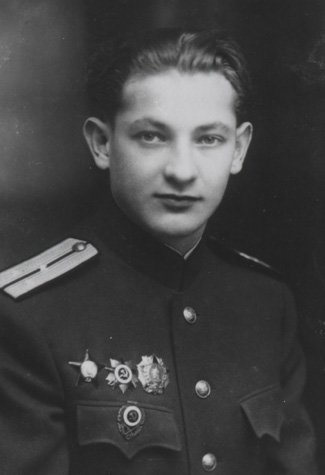
Young NKVD Captain Mieczysław Grajewski wearing his Soviet decorations, including the Order of the Red Star.
We don’t hear about the treatment of Poles by the Soviet invaders from the East – like the Katyn massacre and mass burial in pits of many thousands of Polish officers and intellectuals. No, because the Soviets were protective of the Jews while deadly toward the Catholic Poles, and Grajewski and his family were Jewish. Grajewski eventually joined the Soviet NKVD and whitewashes this decision in his story as being the lesser evil, and because he wanted “revenge against the Nazis.” William Forstchen in his forward to the 2006 edition put it this way:
Toward the end of the war, he was recruited by the Soviet N.K.V.D. And served as an officer. Gray says in his defense that his sole mission was to hunt down those who inflicted the Holocaust, and he deserted when he realized they were the mirror image of the other side.
I can imagine he inflicted plenty of damage of his own on defenseless Poles and Germans in enacting his revenge. According to Wikipedia, his job was to break up the Polish anti-communist underground in the area of Zambrów. Today, on Gray’s Facebook page, you can read:
At 17, Martin is the head of the biggest smuggling organisation of the Warsaw ghetto. He is eventually caught by the Germans and recruited as a Sonderkommando in the infamous Treblinka death camp. All of his family is exterminated there. He manages the impossible feat of escape and participates in the uprising of the Warsaw Ghetto where his father is killed before his eyes.
Consumed with revenge he joins the Soviet Army and becomes the youngest captain at 24.
Let’s understand the Warsaw ghetto was established in October and November, 1940, when Grajewski was 18 1/2 years old, so his claim to be a mere 17 in the ghetto is false. Plus, if he emigrated to the US in 1946, at the age of 24, he could not have first become an NKVD captain in that same year.
The same with his claims about being a Sonderkommando at Treblinka and escaping from there, not just once but many times … and after his final, successful escape to return to the Warsaw Ghetto to participate in the uprising before he becomes a captain in the Soviet Army. Whew! What a hero! According to several holocaust historians, the Treblinka part especially is not true.
But this doesn’t slow down the continuing advancement of his brand. The Facebook page tells us about a new documentary in the works based on the biography that it says has had 30 million readers! It’s titled A MAN. Naturally, his “amazing” life has already been put on film: For Those I Loved (screenplay by Max Gallo), starring Michael York and Brigitte Fossey. It was also broadcast as a mini-series during the 1980’s in Europe. A second, shorter film was made by Frits Vrij : Seeking Martin Gray.
Max Gallo wrote the book that Gray says he never read!
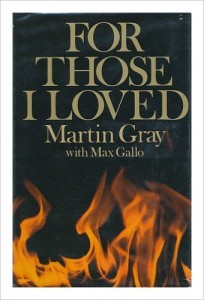
The original book cover, issued in 1971. Gallo was prominently given credit then, but in more recent times his name is no longer featured.
But before I go any farther, you need to know that Grajewski didn’t even write his own fabulous story. The author is Max Gallo, a French politician/historian who was a Communist until 1956; later he switched to the Socialist party. It seems it was Gallo’s idea to write the book but he didn’t begin until after Grajewski had emigrated to the U.S , made a fortune in the 1950’s producing fake antiques in New York City, then moved to France with a wife and child in 1960.
The great tragedy of Gray’s life is not found in the stories of his experience in the Warsaw ghetto and the Treblinka “death camp”, but in the death of his wife and four children in a 1970 house fire that took their lives but which he survived. That was harsh reality, while the Warsaw-Treblinka stories are fiction. It was after the loss of his family that he came out with the holocaust tales, very likely at the suggestion of his friend (or acquaintance?), Max Gallo.
In the 1971 original edition of “For those I loved,” a forward written by his neighbor and friend in France, David Douglas Duncan sheds some light:
“Martin Gray never talked about himself—not before the fire. Never a word revealing where he came from or about his family, or how he lost one eye. For some reason—perhaps it was his accent—I always assumed he’d been born in Russia. But then there were references to Berlin and counterespionage and the American army, and that small-boy grin when he confessed to mass-producing haute époque chandeliers in the basement of his Third Avenue antique shop; chandeliers designed by his luminously beautiful Dutch wife, Dina, who rode herd on the taciturn little Puerto Rican in the basement.”
This does more than suggest that Gray’s holocaust story came late, and was done with the same mentality that dreamed up the fake antiques business. It was Gallo, who was also the ghostwriter for Papillon, the “autobiography” of French convict Henri Charriere which was made into a blockbuster 1973 movie, who brought his exceptional writing skill to Gray’s story, and intended a similar success.
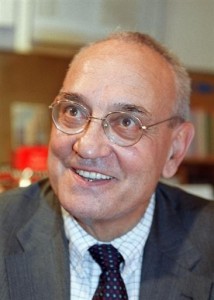
Max Gallo, the ghostwriter of “For those I loved,” the story of Martin Gray.
After Gray and his wife moved to the French Rivera with their one child in 1960, then had three more children — living an idyllic life in a large 300-year old farmhouse near the town of Tanneron — the tragic fire swept it all away in 1970. In the very next year, Gallo’s book was released, with the English translation coming out in 1972. Very fast work by M. Gallo … which is hard to fathom considering Gray’s intense personal pain at the time … but it was very possibly therapeutic.
In their book Treblinka, C. Mattogno and J. Graf point out that in an introduction to the 1971 For Those I loved (which does not appear in the 2006 version), “co-religionist” Gallo describes his writing process thusly:
“We saw each other every day for months. […] I questioned him; I made tape recordings; I observed him; I verified things; I listened to his voice and to his silences. I discovered the modesty of this man and his indomitable determination. I measured in his flesh the savagery and barbarism of the century that had produced Treblinka. […] I rewrote, confronted the facts, sketched in the background, attempted to re-create the atmosphere.”
From this it is clear Gallo is the author, sounding very much like Elie Wiesel when he talks about listening to the silence. And, like Wiesel and Buchenwald, we do know that Gallo totally invented the portion of Gray’s story dealing with Treblinka because industry-respected holocaust writer Gitty Sereny wrote the following about Gallo in her 1979 essay, “The men who whitewash Hitler”:
During [my] research for a Sunday Times inquiry into Gray’s work, M. Gallo informed me cooly that he ‘needed’ a long chapter on Treblinka because the book required something strong for pulling in readers.
If that’s not enough, she also wrote:
When I myself told Gray, the “author”, that he had manifestly never been to, nor escaped from Treblinka, he finally asked, despairingly: “But does it matter?” Wasn’t the only thing that Treblinka did happen, that it be written about, and that some Jews should be shown to have been heroic?
Sereny is concerned about Jewish lies “helping the revisionists.” She admits that “there have been books and films which were only party true, or even were partly faked. And unfortunately, even reputable historians often fail in their duty of care.” (She brings up Martin Gilbert as an example.) She continues, “But untruth always matters […] Every falsification, every error, every slick re-write job is an advantage to the neo-Nazis.”
At the end of the article, she declares, “One other thing assists the revisionists: many Jews, including survivors from the Warsaw Ghetto and Treblinka, are unwilling to bear witness and expose people like Gray for what they are.” What Sereny fails to say is that this is because liars don’t expose liars. Every surlievor account of Treblinka is false, as are most accounts of the Warsaw Ghetto. Sereny wants to believe it all happened as stated in the official narrative, but she is enough of a scholar to be embarrassed and angry by fakery that can be exploited by revisionists. So in 1979 she wrote the above-mentioned article in the very pro-Holocaust New Statesman. I want to mention that Dr. Robert Faurisson wrote a letter to the New Statesman commenting on this very article, which you can read here.
Gitta Sereny is not alone in denouncing Martin Gray as a fraud
Sereny, who is Jewish through her mother, has called “For those I loved” a fraudulent book. She is not the only Jew who has done so.
Graf and Mattogno tell us:
“Even anti-revisionist authors like the French Jew Eric Conan, who speaks of a work “well-known to all historians of this epoch as fraudulent,” [L’Express, February 27, 1997] have castigated M. Gray ‘s hackwork as a blatant falsification.”
At the French web site Enquete & Debat, the holocaust-believing editors have also called Martin Gray’s book a fraud. They say that Pierre Vidal-Naquet called Gray a liar in 1983, writing in Le Monde:
“Max Gallo has rewritten a pseudo-testimony by Mr. Martin Gray that, exploiting a drama about his family, totally invented a stay in an extermination-camp in which he had never set foot.”
Jewish writer Blake Eskin wrote about Martin Gray in his very successful book about another fraudulent holocaust memoir by Binjamin Wilkomirski: A Life in Pieces. According to reviewer Allyssa A. Lapin:
He said Gray’s book first appeared in France in 1971, where it sold 250,000 copies. It was then translated into 18 languages, becoming what Eskin called “an international sensation.”
However, as Eskin reports, before the book was published in English, the London Sunday Times ran an investigative report questioning its veracity. […] none of the survivors contacted by the London Sunday Times remembered Gray. The elaborate train station he described seeing on his reputed September 1942 arrival at Treblinka was actually constructed several months afterwards. […] “It was impossible to see the things Gray said he saw in Treblinka in the autumn of 1942,” one Treblinka survivor told The Times.
[…] Although Gray threatened to sue the Times, reiterating his claim to have been in Treblinka, according to Eskin he never actually filed a complaint. Subsequently, as Eskin reported, Warsaw uprising survivors interviewed by The New Statesman similarly questioned Gray’s “recollections.”
Gray’s French publisher, Editions Robert Laffont, refused to research the allegations, and the U.S. and U.K. publishers also published their editions–and, later, in paperback, which was followed by a film. Only the German publisher halted the presses pending its own research results.
Finally, to top it off — There is a Captain Waclaw Kopisto of the elite Polish Cichociemni unit, who took part in the raid on the German prison in Pinsk on 18 January 1943. In an interview with the Polish daily newspaper Nowiny Rzeszowskie (Rzeszów News) on 2 August 1990. he was shown the wartime photograph of Martin Gray (a.k.a. Mieczysław Grajewski) and said he had never seen Grajewski/Gray before in his life.
Yet Gray/Gallo described his participation in this raid in his autobiographical book that we’re discussing.
Kopisto stated that among the sixteen Polish soldiers in his partisan group there was in fact a Polish Jew from Warsaw by the name of Zygmunt Sulima, his own long-term friend and colleague after the war. No man like the one in the photograph of Gray ever belonged to their unit. Kopisto said:
“For the first time in my life I saw Martin Gray in a 1945 photo, which was published in March 1990 in Przekrój magazine (…) There were only sixteen of us participating in the 1943 Pińsk raid, and he was not among us.” [“Kim jest Martin Gray?” (Who is Martin Gray) Nowiny Rzeszowskie (The Rzeszów News daily), Nr 163, 1990]
It should be plainly obvious why it is that all holocaust surlievor books are considered “stories,” or even “memoirs,” but not history. For the publisher, their accuracy is the responsibility of the author; they don’t accept it as their own. It is only when one of these stories is exposed by someone with enough clout and credibility to get major publicity will the publisher take action and rescind the contract with the author. (As with Herman Rosenblat, another Polish Jew who was exposed by then-big-gun Prof. Kenneth Waltzer.) For the most part, in Holocaust literature anything goes. Only a few holocaust historians will ever speak up against fraudulent stories. Gitta Sereny is one. She has written about Jean Francois Steiner’s book Treblinka:
Steiner’s book on the surface even seems right: he is a man of talent and conviction, and it is hard to know how he could go so wrong. But what he finally produced was a hodgepodge of truth and falsehood, libelling both the dead and the living. The original French book had to be withdrawn and re-issued with all names changed. But it retained its format of imagined conversations and reactions – ie pure fiction – incredibly remaining, nonetheless, in serious bibliographies.
Sereny, however, also looks past a lot of nonsense in order to hold to the official holocaust story line. For example, she herself changes the name of Aktion Reinhardt (which is the spelling the Germans always used) to Aktion Reinhard so she can claim it was named after Reinhard Heydrich — an absurd idea. But on some things she draws the line if she fears, as I’ve pointed out, that their lies are so obvious, and they are so popular, that they will help revisionists tear down the holocaust edifice. For her, Martin Gray is one of those, and I can only agree with her.
*Note: Surlievor = survivor who lies about what he/she survived.
6 Comments
Category Featured | Tags: Tags: Captain Waclaw Kopisto, Gitta Sereny, Martin Gray, Mattgno & Graf, Max Gallo, Mieczyslaw Grajewski, NKVD, Treblinka, Warsaw Ghetto,
Social Networks: Facebook, Twitter, Google Bookmarks, del.icio.us, StumbleUpon, Digg, Reddit, Posterous.
Sunday, May 8th, 2016
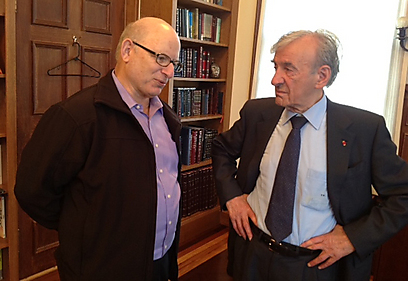
Elie Wiesel, right, in his office at Boston University with his Israeli editor and archivist, Joel Rappel, who announced the discovery of a Hebrew version of “Night” in an exclusive report to Haaretz.
BY CAROLYN YEAGER
The controversy about the origins of “Night” is given more fuel by the recent announcement of Dr. Joel Rappel that he found a 150-page, handwritten document in Hebrew in the unsorted mass of Elie Wiesel’s personal papers.
I wrote about Yoel Rappel’s relationship with Elie Wiesel two years ago. Wiesel selected this Israeli journalist, editor and media expert he has known for decades to have control over how his writings and life story will be presented to the public – meaning what will be presented and what withheld. While Boston University is going to house the Wiesel Archive, it is not in control of it. Wiesel brought Dr. Rappel to Boston, put him on the payroll as “visiting scholar”, then put him in in charge of the Wiesel archive project.
I will go into some detail about this “newly discovered document” but first I want to list the six (oh, that number always comes up, doesn’t it?) versions of Night. They are:
1) 1954 – The original Yiddish manuscript, 862 typed pages, (No one has ever seen this, but more on that later)
2) 1955 – The edited and published Yiddish Un di velt hot geshvign – 245 book pages in Hebrew characters, not our alphabet
3) 1958 – La Nuit, original French – about 120 pages
4) 1960 – Night in English, Stella Rodway translation from French – 107 pages
5) 2006 – Night in English, Marion Wiesel new translation with numerous changes – 112 pages
6) late 1950’s, discovered in 2016 – Night in Hebrew, handwritten by Elie Wiesel – 150 pages (unfinished? – no one has seen this one either)
Which one have you read? They are all different, except for numbers 3 and 4 which are identical in content; thus it’s actually more accurate to say there are five versions, but I’m sticking with six. This latest discovery (#6) seems closest to number two in content, and, in fact, the content is not new if you are familiar with the non-fictional books Wiesel has published over the years, in which all these ideas have been expressed. The Haaretz report written by Ofer Aderet contains the following quotes from the “Hebrew Night”, probably given to him by Rappel. These are passages you won’t find in your conventional Night (#3,4 and 5).
“We believed in miracles and in God! And not in fate … and we [fared] very badly not believing in fate. If we had, we could have prevented many catastrophes. There is no longer a god in the heavens; he whispered with every step we put on the ground. There is no longer God in heaven, and there is no longer man on the earth below. The universe is divided in two: angels of death and the dead.”
And
“I stopped praying and didn’t speak about God. I was angry at him. I told myself, ‘He does not deserve us praying to him.’ And, really, does he hear prayers? … Why sanctify him? For what? For the suffering he rains on our heads? For Auschwitz and Birkenau? … This time we will not stand as the accused in court before the divine judge. This time we are the judges and he the accused. We are ready. There are a huge number of documents in our indictment file. They are living documents that will shake the foundations of justice.”
Also
“Eternal optimists … it would not be an exaggeration on my part if I were to say that they greatly helped the genocidal nation [Germany -cy] to prepare the psychological background for the disaster. In fact, the professional optimists [among the Jews -cy] meant to make the present easier, but in doing so they buried the future. It is almost certain that if we had known only a little of the truth – dozens of Jews or more would have successfully fled. We would have broken the sword of fate. We would have burned the murderers’ altar. We would have fled and hidden in the mountains with farmers.”
This is so disingenuous because Wiesel writes on many occasions that warnings were received but not believed, even by his own father (who was an optimist) because the Jews didn’t want to take action that would discomfort themselves. His own family, he has written, refused help from Christians who wanted to hide them. They did know about the deportations, but they hoped it would pass them by or the Russians would get there first.
“We didn’t know a thing [in Europe], while they knew in the Land of Israel, and they knew in London, and they knew in New York. The world was silent and the Jewish world was silent. Why silent? Why did it not find it vital to inform us of what was going on in Germany? Why did they not warn us? Why? I also accuse the Jewish world and its leaders for not warning us, at least about the danger awaiting us in ambush so that we’d seek rescue routes.”
This paragraph is especially full of lies, and the biggest lie of all is that there was an extermination waiting for Jews. It was not true, no one believed that or feared that, they knew everything anyone else knew. They didn’t know about “gas chambers” because there weren’t any. Wiesel is just looking for someone to blame after the fact. The same is true of the following paragraphs, although his seething hatred can’t be disguised any longer:
“All the residents stood at the entrances of their homes, with faces filled with happiness at the misfortune they saw in their friends of yesterday walking and disappearing into the horizon – not for a day or two, but forever. Here I learned the true face of the Hungarian. It is the brutal face of an animal. I wouldn’t be exaggerating if I were to say the Hungarians were more violent toward us than the Germans themselves. The Germans tended to shoot Jews.” [They never shot him or any of his friends or family, did they? -cy]
“At the end of the war, I refused to return to my hometown because I didn’t want to see any more the faces they revealed behind their disguises on that day of expulsion. However, from one perspective, I am sorry I didn’t return home, at least for a few days, in order to take revenge – to avenge the experts of hypocrisy, the inhabitants of my town. Then it would have been possible to take revenge!”
One last passage included in the Haaretz report is one that is not new; it has received a lot of attention in recent years, even by Wiesel himself. However, the wording here is not the same as in the Yiddish text; Wiesel wrote it differently each time, trying to better express it so his orthodox Jews don’t come off looking bad. Of the trip by rail to Auschwitz, Rappel says, Wiesel wrote in detail in the archived text:
“Under the cover of night, there were some young boys and girls who had sexual intercourse. The initial impact of the disaster was sexual. The tension of the final days sparked the desires that now sought release. And the heat also added its own touch, so that the sexual scenes did not provoke protest in the carriage. Eat, drink and be merry, for tomorrow we die.”
This is a different Wiesel than the author of La Nuit, which was more the product of Francois Mauriac and the publisher Jerome Lindon. La Nuit was written for the goyim, the Christian West, but it doesn’t say everything Wiesel had originally said to his fellow Jews. Later, he put much of it in other books, essays and interviews, and now it’s coming to us in this “new, expanded version of Night.” Why now? Well, Wiesel will be 88-years old on September 30th and is apparently not in the best of health, so people like Dr. Rappel are getting his legacy in order.
Night is a flexible tale that Wiesel adds to and subtracts from at will
Even Rappel is left to speculate as to why Wiesel decided not to publish this work in Hebrew for Israeli readers, but instead shelved it and agreed to a translation by Haim Gouri of the French La Nuit into Hebrew. Rappel says. “I wondered if someone wanted to make it disappear and get rid of it.”
“This is the version of ‘Night’ that Wiesel wanted the Israeli reader to see. He didn’t write it for anyone else. Therefore, it was so important. Wiesel knew that many Holocaust survivors from Auschwitz and Buchenwald, as well as many Jews living in Israel, would read this version, and so he put more emphasis on the Jewish aspect.”
If that’s true, why did Wiesel store it away, deep in his mass of papers? “He knew that, someday, someone would find this manuscript and leave it for the following generations,” believes Rappel.
This last sentence gives away the nonsensical nature of this whole “discovery” of a lost manuscript. If Wiesel wanted survivors to read it, he wouldn’t at the same time hide it from them, allowing only future generations to read it. Seems to me he decided not to compete with his already published version, maybe at the request of his French publisher. At the time he was supposedly writing it – the late 50’s – the English language Night had not yet been published. But Wiesel is perhaps not satisfied with what is left of his “epic” in La Nuit and begins preparing a Hebrew version that reinstates some of his original. What is described here by Rappel as a “hugely different” version of Night is very similar, in fact, to the 245-page Yiddish Un di velt hot geshvign (And the world remained silent) which Wiesel says he wrote in April 1954 on a ship heading for Brazil. [All Rivers Run to the Sea: Memoirs (New York, 1995), pp. 239-40] It appears he was mining that book – returning to what he originally wrote and was published by Mark Turkov as part of the 176-volume Polish Jewry Memoirs Series [Dos poylishe yidntum].
I have always suspected that Wiesel knew about Turkov’s publishing operation in advance of his trip to Brazil since he had close relatives in Buenos Aires who would have informed him about it. He could have used the trip to Brazil to take his manuscript to Turkov in Argentina. The scenario could go like this: Wiesel had been working on his grand “testimony” for several years already and had completed it. On the boat to Brazil, he worked on finishing touches. That was in April 1954. One year later, in May 1955, he meets Francois Mauriac, who urges him to write about his concentration camp experience. Without telling Mauriac he has already done so, he keeps up his friendship with the famous Catholic writer and when the published Un di velt hot geshvign arrives in December 1955, he translates it into French and shows that to Mauriac. Or … another possibility. Did Wiesel not give his “only copy” to Turkov because all along he had a copy at home in Paris? This makes more sense because it is impossible to credit any sane person giving their only copy of a precious manuscript to a stranger in a foreign land, even if he were a publisher. This question has now been answered for me, since it’s come to my attention that in a 1978 interview with John S. Friedman, published in The Paris Review 26 (Spring 1984), Wiesel said he still had the original manuscript:
INTERVIEWER
Have you destroyed the original nine hundred pages of Night?
WIESEL
No, I have them. Others I destroy; Night is not a novel, it’s an autobiography. It’s a memoir. It’s testimony. Therefore I believe it should be kept and one day I may publish it because I have no right not to. It’s not mine. [“it” refers to the ‘original 900 pages’ he believes should be kept -cy]
Contradicting this in his 1995 memoir, he wrote:
In December [1955] I received from Buenos Aires the first copy of my Yiddish testimony “And the World Stayed Silent,” which I had finished on the boat to Brazil. The singer Yehudit Moretzka and her editor friend Mark Turkov had kept their word—except that they never did send back the manuscript. Israel Adler invited me to celebrate the event with a café-crème at the corner bistro. [ All Rivers Run to the Sea, p. 277]
Of course, if Wiesel had one at home, they wouldn’t need to send it back to him. Except … on page 241 he had also written: “It was my only copy, but Turkov assured me it would be safe with him.” So which is right? Rappel quotes from Wiesel’s memoir several times, thus I believe he would think it necessary to go with the memoir over the interview. However, it’s a major contradiction and I wonder if he would be willing to attempt an answer to it.
So right now the burning question is: Will Dr. Joel Rappel find the original typewritten 862-page manuscript in Elie Wiesel’s 330 boxes of material, as he found the 150-page handwritten Hebrew Night? It should be there since Wiesel told Friedman he kept it. Or did he destroy it between 1978 and 1995 because he no longer believed it should be kept? Or is Rappel keeping it hidden for reasons of his own, perhaps because of the many contradictions that undermine the integrity of Wiesel’s memoir? The only thing we know for certain is that we’re dealing with dishonest people so we can’t expect we’ll ever really know. Most ‘holocaust survivors’ wait for all witnesses to die before they tell their story and Wiesel is no exception.
This is my first question, but there are others, such as: since Un di velt hot geshvign is a published book, those who know Yiddish can easily read it, why therefore does Rappel ignore it? I have included portions of it translated to French and English here at Elie Wiesel Cons The World. Naomi Siedman, a professor of Jewish studies, has written a well-known article quoting from it, as have others. Yet Rappel speaks of these passages as if they were previously unknown. Well, to the general public, they are.
The archived version of “Night” is hugely different to the published one. It contains entire sections that don’t appear in the finished book, as well as different versions of pieces that were included.
True enough, but is Rappel not familiar with the Yiddish book that Wiesel claims to have written or does he want to discourage attention to it?
Siedman also noted significant differences in the ways each book reveals Wiesel’s writing process: In the Yiddish memoir (#2), he starts to write immediately after liberation, while the French text (#3) says he started writing only after a 10-year vow of silence. I have discussed Siedman’s commentary here.
Night: Clearly a work of fiction
An article in the Jewish Journal from 2013 gives an interesting insight into Wiesel’s insistence that his book Night is in no way fiction.
‘Holocaust scholar’ Michael Berenbaum has known Wiesel well for 35 years. Berenbaum wrote his doctoral dissertation in the 1970s about Wiesel’s work and later worked with Wiesel on the council that created the United States Holocaust Memorial Museum in Washington, D.C., in the 1980s. He declared that “Wiesel’s moral power base is directly related to the moral stature that has been accorded to the Holocaust.” (That is, without the public’s belief in the ‘Holocaust’, Wiesel is nothing.) Berenbaum volunteered to Jonah Lowenfeld:
“If you want to get Wiesel angry, all you have to do is call ‘Night’ a novel instead of a memoir.”
In that same article, Gary Weissman, an assistant professor of English at the University of Cincinnati, said he finds Wiesel’s celebrity a distraction.
“I have found that Wiesel tends to be ‘celebrated’ rather than questioned in any probing way. Many are investing in treating — and experiencing! — Wiesel as a holy figure, rather than as a complex and real human being.”
How very true. And it’s guaranteed to get worse, what with his ever-advancing age. I don’t have a clue what could put the genie back in the bottle when it comes to the over-inflated reputation of this man, other than taking the media out of the hands of Jewish monopolies.
Sunday, April 24th, 2016
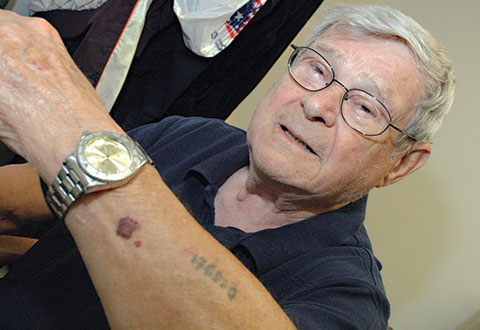
Paul Argiewicz proudly shows off his Auschwitz tattoo which is his best proof he is a holocaust survivor. But it’s the details of his story that are suspect, as is true of all ‘surlievor’ stories.
By Carolyn Yeager
THERE HAS NEVER BEEN a survivor story that passes the test of truth and accuracy – not one! Isn’t that amazing? They are all filled with exaggerations and downright lies. And that really tells us something, because “the Holocaust” is in actuality nothing more than a collection of survivor stories. I am not an expert in revisionist historiography, but I think I can say with confidence that no scientific/forensic evidentiary support for a “Holocaust” exists. Documentary support is both sparse and dependent on questionable or uncertain interpretations. That leaves us with witness accounts from those who were in the concentration and work camps to tell us what “the Holocaust” was.
It’s been known for a long time that eye-witnesses are the least reliable evidence for what really happened in any given situation. Forensic evidence is the best, and even circumstantial evidence is superior to eye-witnesses. The stories that were told by false eye-witnesses in 1945-46 were outlandish compared to what we believe today. Far-fetched and grotesque accusations of sadistic methods of killing were made against camp authorities and guards and then soberly reported in the world’s news outlets. The remaining leaders of National-Socialist Germany were executed by hanging after being found guilty by an unlawful tribunal of war victors without so much as a peep heard against it in the mainstream media of the time. With the help of the Internet and revisionist historians, we have come a long way since then in using our critical judgment when it comes to blatant atrocity propaganda. Now I think it’s time to encourage even more and tougher critical thinking about the stories survivors have told and are still telling.
There are certain elements all the stories have – that’s why they’re a genre. They’re almost all written by Jews. They describe awful conditions in the camps with more generalization than specifics, ie. barracks, food, work, supervision, guards and, of course, Dr. Mengele if they were at Auschwitz-Birkenau. One common observation made by those who arrived by train at Birkenau is that they saw in the distance smoke and flames coming out of the crematorium chimney. Sometimes there was a bad odor. It is known by people educated in these matters that cremation does not create smoke or odor, and that flames cannot leap out of a chimney unless it is dangerously malfunctioning. But enjoinders to stop contradicting the laws of nature and science make no impression on these story-tellers. They are following a higher law of “Never Again,” which makes lying permissible and the impossible possible. I’ve come up with the word ‘surlievor’ for them, which I’ll use from here on.
With this introduction in mind, let’s look at Paul Argiewicz’ story again. I wrote about this man last week and tried to stress two major points: his lies about his birth date and about being in the Famous Buchenwald Lieberation Photo. But when I read fully through the Oral History he did with the Wisconsin Veteran’s History Museum, I discovered a few more major problems in his story. Using the critical method on Paul’s Story will show us why all surlievor stories are just that — stories so fictionalized that they are totally unreliable as history. They are meant to propagandize, and they do, but for most who read them, they also serve as entertainment in the widest sense.
The real Paul Argiewicz
If you read the above-mentioned oral history interview and then read Paul’s obituary placed in his hometown newspaper you find some very different facts in the places where it counts most. For more than a decade before his death at age 88, Argiewicz was known as a regular out-patient at the veterans hospital near where he lived. The personnel there, along with the U.S. Social Security Agency, the Veteran’s Administration, and other agencies he dealt with, had his correct date of birth. That’s why his obituary gives it correctly as 1925. Then there’s a newspaper report (also here) of a 2010 presentation he made to a high school group that is different still. I have not read the biography written by Deanne Joseph, but I know that she fictionalizes his story too. I’m sure the “Oral History” from the year 2000 is more revealing than the story written by a professional writer hoping for a best-seller – or at least a good seller able to fulfill the curriculum needs at thousands of middle schools. In this interview at least, the real Paul Argiewicz does come through.
Some trivia: Even though the interview took place in 2000, it was not transcribed until 2008-09. The book by Deanne Joseph also came out in 2008. Katy Marty transcribed the interview; it was corrected by Channing Welch, after which the corrected copy was typed by Katy Marty. Since the interviewer James (Jim) McIntosh and Argiewicz talked over each other fairly often, it’s evident these ladies did a commendable job.
Sheryl Erdman Argiewicz, Paul’s wife, is present and says something from time to time. Right in the beginning Paul says, “Why don’t I have my wife with me?” and Mrs. A, who is apparently not seated just right next to him, says, “No just do it on your own honey.” Then she added, “I’ll just prompt you when you forget, alright?” And several times she answers questions for him.
At the time of the recording, they have been married four years. Paul is 75 years old. This is important because, from what he says later in the interview, he didn’t began to speak about being a holocaust surlievor until after they married in July 1996 when he was age 71. His first wife had died and he began looking for another. He said of Sheryl, “She was available,” but not in a derogatory way. He was clearly very dependent on her.
The revelation that, like so many others, he didn’t talk about the holocaust until after Schindler’s List became a big hit in 1993 and Hollywood made being a surlievor fashionable, puts the biggest question mark around Argiewicz, to my mind. Surlievor “meet groups” cropped up at that time wherever there were a lot of retired Jews. They got together and told their stories to each other, while Stephen Spielberg got the idea to tape record and archive as many surlievor stories as possible – thousands of them! [Thanks to Eric Hunt, we have been able to see a lot of them and can easily recognize the nutty things and enormous lies so many of them tell.] It sure appears it was Paul’s new wife that encouraged him to “go on the speakers circuit” as a holocaust surlievor. In fact, Sheryl’s daughter Cindy is one of the biggest boosters of her father-in-law’s story.
13 Major problems in Paul’s one-on-one interview
1. He didn’t speak publicly about being a holocaust survivor until he was in his 70’s, after remarrying in 1996.
Page 56: MR. A: And we knew each other [his current wife Sheryl]. And she turned a lot in my life, a big change in my life. Literally, I couldn’t talk to you. Like you would ask me today about the interview what you give me. I would never give it to you. I would walk out.
JIM: Too tight?
MR. A: I was so tight I would walk out. I just, I just didn’t work. And this lady here made about face. She opened me and I became –
Unfortunately a major interruption occurs at this point and he doesn’t get back to it. But he’s telling us he never spoke about it and it is Jim who puts the words “too tight” in Paul’s mouth. Jim is very often doing this, or finishing Paul’s sentences, and Paul just accepts the word Jim gives him. Not what should happen in something billed as an Oral History
2. Claims he was born in 1933, when his actual birth date is 1925.
Page 6: MR. A: I was born in Bielsko, Poland.
JIM: Boy, you better spell that one.
Mr. A. B-i-e-l-s-k-o, Poland.
JIM: When?
MR. A: In 1933.
JIM: ’33?
MR. A: Yeah.
This is pretty ridiculous because he makes himself 8 years younger when, according to his own story, he should be 5 years younger. Jim even gave him an opportunity to change it, yet Paul stuck with 1933 and his wife didn’t correct him. In a speech to a Jewish group I just happened to see on Youtube yesterday, he said: ‘In 1939 I was 10 years old,’ making his birth in 1929. So you see how it moves around.
3. Claims he was 10 years old when his family moved to the Sosnowiec ghetto, which would have been in 1943 according to the birth date he gives. And his wife answers for him.
Page 8: MR. A: First I got into ghetto in Sosnowiec.
JIM: Age? Your age?
MRS. A: Ten, when you went in the ghetto.
MR. A: In the ghetto I was ten.
Sheryl apparently didn’t trust him to tell it right, or maybe he paused. But the timing is way off , showing that they don’t seem to get it that his dates are not aligned. Nor do they consider whether one part of his story fits with another part further on. If he was born in 1933, he was 10 in 1943. The Sosnowiec ghetto was liquidated in 1943, with the inhabitants being sent to Auschwitz-Birkenau. The real Paul Argiewicz was 18 years old in 1943!
4. Claims he was only 11 years old when “arrested by the Nazis”. But what year is it? He never tells us the year, only his age.
Page 9: MR. A: Okay, and we were in that ghetto for almost a year.
JIM: Your family?
MR. A: My whole family.
The Sosnowiec ghetto was formed over time, from 1940 to 1943, with transfers of Jews from the surrounding areas. According to the Wikipedia page (which is really useless) it wasn’t “closed off” until March 10, 1943. The real Paul Argiewicz was 11 years old in 1936 – that’s a long way from living in the ghetto. One has to doubt his entire “arrest for stealing bread” story and conclude he was simply deported to Auschwitz with the rest of his family in 1943.
5. Claims he told the SS officer in charge that he was 18 and was believed.
Page 10: MR. A: And a guy behind me kicked me in the shin and said to me in Jewish he said to me, “Say to him that you are 18.” And I was almost, I was just about eleven years old. But I was very husky built and strong. [He was a short person with a baby face. A minor problem here is that Paul says further on that he only learned Jewish in the camps but he understood this guy talking to him in “Jewish”, meaning Yiddish.]
MR. A: I said, “Eighteen.” I became instantly eighteen years of age. [Funny that in 1943 he really was 18 years old!]
JIM: Here, here
MR. A: So from the beginning you had your name and they kept your address, whatever it was. They sent me to a camp, what it was actually an “arbeitslager”, a work camp and we were working on the Autobahn.
So he gave his address, he says. It’s possible he was sent to work on the Autobahn at first, since he was the right age – 18. Strangely, his surviving sister Lucy, around his age, has said nothing one way or the other [maybe she doesn’t want to contradict her brother], although her husband tells of his experiences after the Germans crossed into Poland when he was 13 years old – he was one year younger than Paul, in the same town, and they were friends. Matzner says his family lived in the ghetto until 1942 when all the Jews were sent to Auschwitz. He was young (16 then) and able to work. It would have been the same for Paul’s family. But Paul wants to stand-out from the rest … by being arrested and incarcerated as a child. His sister and her husband just stay quiet about it
Note that in the article Robert Matzner tells of lucking out with a work assignment in a surveyor’s heated office because he could speak German, and being brought sandwiches every day by the secretary. Remember this when we get to the “sandwich” part in Paul’s story.
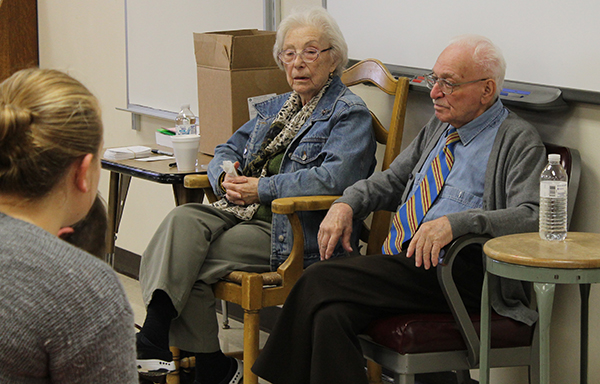
Lucy Argiewicz Matzner and Robert Matzner speaking to 8th graders at Riverview Middle School in Wisconsin about “genocide.” Robert said he spent time in six different camps, all about the same, with little food and 14 hours of hard labor a day. The work days were actually only 8-10 hours and the food was sufficient until the very end. Why do they all have to exaggerate their hardship? They’ve lived a great life ever since.
6. Claims he was multilingual from the start, spoke perfect German
Page 10: MR. A: …where I come from– It’s on the eastern part, southeastern part of Poland. […] So it was very close to Germany, and close to Czechoslovakia. That’s why I was born with three languages. I speak fluently German, Czech, and I speak Polish.
MRS. A: English, of course.
MR. A: And Jewish I didn’t spoke until I got in concentration camp.
This is only a problem in his story in that it would have helped him get along with the Germans running the camp. He says he worked as an electrician, but just bluffed his way through. Not possible to bluff electrical work! But being multilingual enabled him to collaborate with the authorities and get cushy positions where his languages – especially German – were useful. So I’m questioning his suffering. He’s torn between representing himself as a starving laborer and bragging about how important he was. Everything he says about work is sketchy and disjointed; he avoids talking about it because he doesn’t want to be seen as a rat. That may be one reason he came up with the 11-year-old child story.
I’ll add that what he calls perfect German could not have been perfect (but passable) considering how terrible his English is.
7. Claims in the camps they were fed only 1 kilo (2.2 lbs) of rye bread made with sawdust or other filler daily along with potato/vegetable “peelings” made into a watery soup. In addition, he said a bowl of ‘watery’ oatmeal was given at noon to those who worked.
Page 17-18: JIM: Tell me about feeding you. How about eating.
MR. A: The food that we used to get about in the evening you used to get I would say kilo bread, rye bread, about a portion like this. It was filled full with filler. It was not flour. It was — Sawdust. — to fill it up. It was very low in calories, and practically nothing in protein, but one thing the Germans didn’t know about. That they were feeding us. They were feeding us with peelings, dried up peelings. And this (unintelligible), that was very high in protein, very high in vitamins. This, they had this – this they thought that the —
JIM: Peelings of what? Potatoes?
MR. A: Potatoes,
MRS. A: Carrots, vegetables —
MR. A: Carrots, cabbage, anything would work.
MRS. A: Animal feed –
MR. A: In a soup, cooked in a soup.
JIM: Yeah, that, and bread that was your meal.
MR. A: Very thin. That was main stable.
MRS. A: And oatmeal, watery oatmeal in the morning.
MR. A: The oatmeal we were getting around lunch time. The people what worked only. The people what didn’t work got only one meal a day. They didn’t even get —
JIM: If you worked you got two.
MR. A: Yeah. You got two meals. You got the bonka suppe. The “bonka suppe” that used to be … Was watered down oatmeal just like I would say a little bit thicker then that water.
This doesn’t compute with what the German records show and with what many others say, but it does match what the worst of the surlievors say. Germans were not stupid enough to think starving people can make good workers. Everyone got at least two meals a day; physical laborers got four. They also were allowed to receive food packages from home and from the Red Cross and Jewish agencies. Even though Paul likes to talk about starvation, it was not happening, certainly not to him.
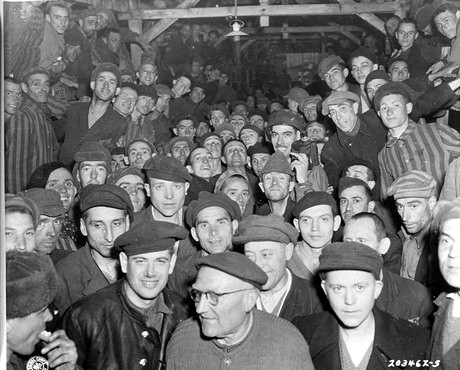
“Starving” Buchenwald prisoners at liberation. They sure look well-fed to me.
8. Couldn’t say how deep the bunk beds were in the barracks, whether 3 or 4 layers. Said he could show a picture from a magazine!
Page 19: JIM: The bunks were how deep or how high?
MR. A: Ah, in some places we used to have three and four —
JIM: Three or four?
MR. A: In Buchenwald I remember, what was it, three or four I think. Was it three there or four layers?
MRS. A: (unintelligible) three.
MR. A: Whatever it was. I have pictures. I bet, in fact I’d like to show you the picture from U.S. News and World Report.
This is a good place to remark that there is not a single picture of our hero in any camp, or anywhere, from this period. We are taking his word that he was there. Like Wiesel, he thought to prove his claim by identifying himself in that “Famous Buchenwald Photo” but it hasn’t worked out. He’s not in it. It’s pretty funny that he can’t say immediately how many layers to the bunks in Buchenwald if he was there, as he says, for 4 months — It’s hilarious that he asks his wife — he thinks she knows more than he does!
9. Claims he worked as an electrician in the camps. How did he become an electrician?
Says he was only a couple of days at Auschwitz (long enough to get a tattoo), then was moved because “I said I could work.” Says “They moved because they needed electricians.” He appears to mean going from Auschwitz to Blechhammer , not from Blechhammer to Buchenwald in Dec. ’44. I wasn’t able to find any information on quarries at Blechhammer, but we know there was a big one at Buchenwald.
Page 20-21: MR. A: The people would work in the steinbruch [stone pit], like in the quarries, or on the railroad they had no communication because they were all in gangs. Like in chain gangs. [not actual chain gangs] But I was working with a civilian as an electrician so I used to go around –
JIM: Outside the camp or inside?
MR. A: Outside the camp and inside the factory. The factory was almost thirty square miles. Blechhammer, ooh, that was one of the biggest AEG farm industry plan.
JIM: You mean continuous building, or did it just multiple buildings?
MR. A: There were hundreds of buildings in all different sections. They were making out of the coal gasoline [End of tape 1, side A ca.30 min] gasoline but the factory was still in process of building it. They were not completed. Then the Americans and the British denied it to be finished, but they already produced gasoline, because this was the most important thing because out of coal you had almost a hundred different products.
MR. A: Because they used to make ah, medicine out of it. They were making oil, gas, — Soap, whatever petroleum by product was producing.
JIM: How did you get there? [meaning into the big factory buildings at Blechhammer]
MR. A: How? Because I used to go with this man. Every day the guy, I used to come to him in his little cubbyhole he had. He had a few electricians with him working. He used to be the foreman and I used to be his go-fer.
JIM: Did you walk to this job? Or –
MR. A: No, the SS men used to bring me over to drop me off and he had to sign every day a paper.
JIM: This is how far away?
MR. A: Oh, I would say maybe a half a mile.
MR. A: Okay. So I came there and he says, “All right.” “What I did was in the morning, used to come I put the water on so coffee and I worked with him, oh, maybe a month. He was very leery of me, very careful with me. After all, I still was a dirty Jew. This was at Buchenwald.
JIM: And he was a Pole. A Pollock?
MR. A: No, I wouldn’t trust him. I was, he was a real German.
He was talking about Blechhammer, then the SAME STORY moves to Buchenwald. It’s totally confusing. He was never an electrician at Blechhammer if he wasn’t one when he got to Buchenwald. Says he was only a ‘helper’, a ‘go-fer’ in Buchenwald, probably because he spoke German and could work for the Germans in charge, or even Czech or Polish skilled workers. But he passes himself off as an electrician and Jim lets him do it.
Another thing that comes through with Paul is that he likes and respects Germans. He obviously had a lot of interaction with them. So he blames all the bad stuff on Nazis and Austrians (says Hitler was an Austrian, not a German!).
10. Also claims he learned electrical work in Buchenwald in January-February 1945 – a wild story.
Continued from above … page 21-23:
MR. A: He was a German and a very kind person. I never realized yet what this man was. So after a month working with him he comes to me says, “Pauliken, stop with your lies. Tell me the truth. You are not an electrician, are you?” And I looked in his eyes, with tears in my eyes, I remember that, and I said, “No.” That saved my life. [Everything saves his life. He’s obviously sensitive to the fact that he survived when so many didn’t, as the story goes. But also, it would not have taken the German foreman an entire month to discover Paul was not an electrician!] And he hesitated for a second and he closed his eyes and he took the pencil like this, he put it down. He closed his eyes, he put his hands like this. When he opened his eyes he says to me “Paul, Pauliken,” he said, “you know –
JIM: Little Paul.
MR. A: “Little Paul,” he said, “I will save you. Whatever I can, I will do but I want you to keep your mouth shut. Whatever people ask you, ‘I don’t know’, – and they won’t ask you for anything.”
MR. A: “You haven’t seen anything.”
MR. A: I don’t know anything, and that’s going to be the best thing. So all of a sudden he opens this little box. He gives me a sandwich. I never had a sandwich like this even when I was a kid.
MR. A: So he gives me a sandwich. I ate the sandwich. He says, “Don’t ever say nothing.” A week later he came to work. Well, he comes every day, but he came with tears and crying and everything. I don’t remember his last name. I said, “Hans, mit zu Ruhe?” And all of the sudden he breaks down. He says, “I lost my mother, I lost my wife, and I lost my children in Dresden in the bombing. He said, “I have nothing. What did that animal do to us.” He didn’t say the word Hitler.
This is Feb. 15, 1945. But he would never have addressed this man by his first name; plus Hans is a common German name to easily come up with. He “doesn’t remember his last name” so that he can’t be tracked in camp records and found not to exist. Most importantly, he’s making out that “good” Germans like Hans hated Hitler. And does the sandwich idea come from his brother-in-law’s story? I suspect so.
JIM: Right.
MR. A: He says Was has das, no, he said “Welche art schweine mach” to us, what kind of swine, what he did to us. And I didn’t say a word to him. He became so close to me.
No German at that time would have blamed Hitler for Dresden. Never. This simply didn’t take place.
JIM: You were a replacement.
MR. A: I was his – and when the SS men came he said, “Oh this kid? He is essential. He is such an important person. He knows everything.” And he by teaching me how to wire things and how to do things, and he says, “Certain things I used to do backwards on purpose so they would have to call you to find if there’s any troubles on the line because you know about it.” And he says, “You’ve got to be so important that they will not kill you.” And when we used to go over there when the angriffe [attack] used to be the luftangriffe [air attack], the bombing used to come, and you could hear the siren. Everybody went for the shelters. They wouldn’t let prisoners from concentration camp people in the shelters but they let me in.
So he taught Paul to “wire things,” and even backwards, in one month? And this was in Feb-March 1945, after Dresden? It’s just not credible.
MR. A: I had the special ribbon on my thing.
JIM: Oh, really?
MR. A: Uh huh, and I had a special instrument to save those instruments for testing. I used to carry them. He [Hans] said, “You grab those and run with them. They gonna have to let you in because these instruments are more important than you.” And that’s how I saved my life. And a lot of guys got killed.
MR. A: And he used to be a foreman. He used to be a very big person at Blechhammer. And he taught me how to wire the turbines. This was got to be a perfect job. You can imagine the turbines were, each turbine was as long as this room here.
“He” can only mean “Hans.” But now “Hans” is at Blechhammer and teaching Paul to wire turbines! If he did this at Blechhammer, he would not say at Buchenwald, “Tell me the truth, you are not an electrician, are you.”
In any case, never would an uneducated teenage Polish hooligan like him be allowed to work on the turbines at Blechhammer. Plus, Paul said he made his living as a steamfitter in the United States, not an electrician.
11. Said the only day off was Sunday and “all you had [was] hazing, hanging, beating.” And sometime when they came back from work they had to watch “four or five people being hanged.”
Page 29: MR. A: Because when I stayed home for some reason on Saturday and Sunday we didn’t work.
MR. A: No, Saturday we worked Sunday the only one day we didn’t work. That’s all you had hazing, hanging, beating. [It was generally the rule at Auschwitz camps to work til noon on Saturday, then have the rest of the day and Sunday off. We know the inmates engaged in recreation. So he was right the first time.]
JIM: Oh really.
MR. A: Hanging, and sometime when we came from work we had to stay in crowd watching four or five people be hanged. Terrorizing people, keep them for no reason. For nothing.
JIM: Just for entertainment?
MR. A: Just for entertainment, yeah. When I used to come in through the doors and I could hear the music playing, they had a four or five guys’ instruments and when I heard the music playing we knew right away there would be hanging. And the worse thing one time happened to me, this I never will forget. I was already about two years in Blechhammer on Yom Kippur Eve. You see he knew about it. How did I know all these things? I worked with this guy, sometime I used to pick up an old paper what be thrown away.
Shades of Elie Wiesel’s Night. I have not seen anything about public hangings at Buchenwald, but the discipline in the camp was totally under the control of the communist inmate organization, who had managed to take it over in 1943, not the SS. I would bet Argiewicz never saw a hanging in his life. He doesn’t describe anything about it – how, who, why, etc.
We don’t learn “what happened to him one time.” He started talking about the Voelkischer Beobachter and Julius Streicher instead, and Jim never brought him back to it.
12. Claims before liberation in Buchenwald, in his barracks they were frying human bodies for food – “Take a knife and cut off the flesh and eat it.”
There is a story of cannibalism at Bergen-Belson; I don’t know how true it is. It comes from a General quoting a medical officer.
“The prison doctors tell me that cannibalism is going on,” the medical officer said. “There was no flesh on the bodies; the liver, kidneys, and heart were knifed out.”
But I don’t find anything at all about Buchenwald. Argiewicz must have copied what he had read about Belsen. He stresses several times how much reading he’s done, that he is self-educated. He talks about the day of liberation on page 35:
MR.A: On one morning I get up, I hear shoot – we were making fire and frying human bodies. Take a knife and cut off the flesh and eat it.
JIM: Where was this?
MR. A: In Buchenwald.
JIM: Who was doing this?
MR. A: We did, the inmates because there was no food.
MR. A: We became a lot of guys became –
JIM: Cannibals.
MR. A: Cannibals. That’s sad. So, one morning I hear shooting and trembling and I look outside and here I see a green tank with white markings, you know, olive green come right through the gate, not through the gate, through the barbed wires. And I see he stopped and I see the turret with the barrel facing one of the towers when all of the sudden a salvo I hear. The whole tower, you know can imagine, what is it? A hundred,what is it? A big barrel – I heard a salvo.
Jim wasn’t interested in finding out whose bodies they were cooking! Were dead bodies just laying about? Paul would like you to think so. Jim doesn’t care about telling lies because he does it too. On page 54:
JIM: You havin’ fun –
MR. A: Give you a lot of baloney. (laughs)
JIM: Oh sure, I like that.
13. Claims he was on a four-week death march from Blechhammer to Buchenwald in November 1944.
Page 38: JIM: Tell me about the death march.
MR. A: When the Germans were caving in, they were losing the war in the east, and the German army already, the Russian army already entered Poland and as they were going towards Germany so they came by Kattowitz, Katowice. This was right on the German border with approximately I would say maybe sixty kilometers, seventy kilometers about 45 miles from our camp. One day they gave each one of ‘em whole loaf of bread and took us on a four week death march. When we left there were about 3,000 prisoners. By the time we got to Buchenwald there were only 800 left, maybe, and whoever couldn’t walk, they came and rolled you over with their foot, you know on your back. They shot you. That was their favorite, right here. So when they shot you they gave you instant, instant death. You didn’t even feel it, you know when you get shot right through, through the back, and that was their favorite.
From Jewish Virtual Library:
On January 21, 1945, 4,000 prisoners, including 150 women, were taken out of the camp and put on a death march lasting 13 days.
Page 39: MR. A: It is sad to say lot of these guys escaped into this country. And a lot of ‘em [speaking of “Nazis.” And what about all the horrible Jews like Paul that escaped into this country?]
JIM: Yeah, that’s another subject now. Let’s not get off into that.
MR. A: I know, but I would like to tell you about it, the subject, how –
JIM: Yeah, I’m perfectly willing to listen to that. It’s just that I don’t want to get off our track here.
MR. A: Off our track, right. But what happened, we got into Buchenwald and the day when we got into Buchenwald, not to Buchenwald, to Blech – to Weimar. So of course the American pilots didn’t see that we were on the bottom. [They were now in a train, which he forgot to mention] And most of the guys what used to be in the open railroad and cars and when the artillery starts shooting I can imagine, you can imagine, the shrapnels were flying all over, and I knew and I could see how the guys were killed in the cars, so I jumped out of the car, railroad car, because the guards ran away. They hid in bunkers. And I jumped underneath the train, the railroad car and I got saved because sometime, you know, the metal pieces, and when I came back I saw half the car was dead. [Did nobody but him have the idea to jump out of the car?]
[…]
MR. A: Because, you see when we left on the march it was in November, November, and then we got into Buchenwald, I think it was in December.
JIM: You were on the road a month?
MR. A: About a month, yea.
All sources I find put the march from Blechhammer to Buchenwald beginning on Jan 21, 1945, lasting 13 days, half the time Paul claims. He says it was November and they arrived at Buchenwald in December 1944. Big discrepancy here. There were not two marches, only one. Why is Paul so confused? Does he want to give himself a longer stay at Buchenwald? If he didn’t arrive until February, he wouldn’t have had time to get in tight with “Hans” before the Dresden bombing. Or is he just guessing … badly. I think his entire Buchenwald story about Hans is fiction and he added it in competition with his brother-in-law whom he’s known since childhood. He was probably in Buchenwald for a couple months and it was uneventful.
Some final quotes
Page 37: MR A: Well, that’s when I was liberated. I was not liberated in Auschwitz, because they evacuated us from Blechhammer. This was about maybe sixty, seventy miles from Auschwitz. And Auschwitz what they did they gave me this number, and I was there only a couple days because over there I bluffed myself through, too, because there I said that I can work. See this was my number. Can you see the number? 1-7-6-5-2-0. [Auschwitz was a transit camp. in addition to being a concentration camp in Birkenau.]
Page 38: MR. A: They moved because they needed electricians.
JIM: You were an ace by then. (laughter)
MR. A: Oh, I was an expert. I was a real expert (laughs), but I tell you but it worked. It worked. [He pretends it worked; it could not have worked. He was doing something else.]
JIM: So you went from one camp to the other?
MR. A: To another camp and they brought me then –
JIM: So you were liberated from Buchenwald.
MR. A: I was liberated from Buchenwald and that was, Buchenwald was outside Weimar. Weimar, do you remember that was the capital city of the Weimar Republic?
JIM: I know. Weimar Republic. Yes, I know that.
The capital was Berlin, which just shows how much critical attention Jim is paying. Whatever Paul says, Jim goes along with it. And that is the reception surlievers get from everywhere since the 1990’s, and earlier. It’s been so easy for him — no matter what he says, it’s accepted, no questions asked. So why not embellish the story? Why not add a bit more zest to it, why not punish the Nazis even harder, even if they treated you decently. It needs to be done for “Never Again.” It’s the same with Robert Matzner and all the hundreds of surlievers who go on the speakers circuit and engage a ghostwriter to put their story in a book. It has to be interesting, doesn’t it? We want it to sell. It’s for a good cause — for shutting up the antisemites. The deniers. For Israel. For our children’s future and safety. For all these reasons and more, we need to keep the story going.
For us on the other side, who are the victims of this hoax, we need to bring a hard critical spirit to every one of these overblown, nonsensical stories written by Jews. Not a one of them can stand up to scrutiny. (If you think one can, send it to me.) It’s just this scrutiny we don’t have enough of. Nor the media power to communicate the scrutiny we do have to large enough numbers of hoaxed and passive believers. We’ll just have to keep working at it because continuing with the status quo is not an option.
2 Comments
Category Featured | Tags: Tags: Blechhammer, Buchenwald, Holocaust fraud, Paul Argiewicz,
Social Networks: Facebook, Twitter, Google Bookmarks, del.icio.us, StumbleUpon, Digg, Reddit, Posterous.
Sunday, April 17th, 2016
BY CAROLYN YEAGER
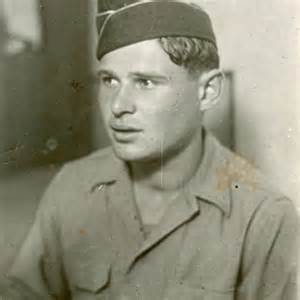
This is a picture of Paul Argiewicz used by the Wisconsin Veterans Museum but with no description. Considering he’s wearing a US Army cap it has to be from after 1950, which would make him over 25 years of age.
Remember Paul Argiewicz? He’s the guy I wrote about here because it’s widely claimed he’s in the Famous Buchenwald Liberation Photo, which he is not. But there are a lot of things wrong with the Paul Argiewicz story – claiming he is in that photo is just one of them.
Christine Miller has observed that being forced to believe holocaust survivor’s stories has made Western man irrational. Paul’s story is as irrational as any, especially when it comes to the simple act of adding together two-digit numbers. So let’s start there.
Paul’s date of birth is always given as Aug. 6, 1925 in Bielsko, Poland. He grew up using his mother’s name, Argiewicz, because his parents were not formally or officially married. The family included two older sisters. He told interviewers that he only went three and a half years to grade school. He was arrested in 1941 by his own reckoning, when he would have been 16 years old.
However, his story, wherever you look either online or in the book about him, states that he was age 11 at the time of his arrest by the Nazis, and in his own obituary written or approved by his family it says “he was arrested at age 10 by the SS for stealing bread for his starving family in the Jewish ghetto.” [The ‘stealing bread for starving family’ part is obviously fiction, but Paul was known as an emotional person who cried easily and liked to create as much sympathetic reaction in his listeners as possible.]
So what’s going on with this man? And with his family and biographer? Can’t they add? It’s apparent that holocaust survivors have become so complacent because of their experience that anything they say will pass that they actually believe “anything will pass.” Even to the point that if you’re born in 1925 you can be 11 years old in 1941. Think about it. The year of Paul’s arrest is not always mentioned as it is here, but we all know the camps were liberated in 1945, and we know he turned 20 in that year. Precisely, he was 19 on April 11, 1945, four months shy of his 20th birthday … not 14.
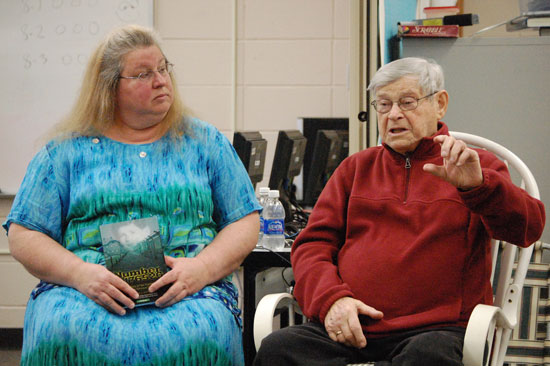
Deanne Joseph Ebner (left) who wrote the book “Number 176520: The Story of Paul Argiewicz ”A Teenage Holocaust Survivor” appeared with Argiewicz in 2012 at Riverview School.
What makes this age imposture important enough for Paul and his biographer to try to slip it past most readers? The craving for attention. Paul separates himself from the crowded field of fellow “survivors” by billing himself as a “child survivor.” He describes himself as being still a teenager when he was released … which he was, even if just barely. But he wanted to be younger still … a child. And what is surprising is that he basically has gotten away with it! I have not come across anyone questioning the claim that Paul was 11 when he was arrested, even though he was born in 1925. [I notice he told the Wisconsin Veterans Museum interviewer on page 7 that he was born in 1933!]
This type of “pass” can be better understood from a question by a poster commenting to another “survivor” who claimed he rode in a packed train car for 6 days with no food or water and no stops:
Did anyone die midway in the six day train ride with no food/water? I’m by no means doubting, just asking a question. As someone has mentioned below, you CAN survive without water for about a week.
God forbid these young people should doubt anything said by a holy survivor, no matter how unconnected to reality. The “survivor” answered he didn’t recall any deaths. But the point being, we don’t ask questions – we’re ashamed or afraid to question – and it leads to utter nonsense.
After doing more than a bit of research into Paul Argiewicz, I’ve come to the conclusion that there is also a felt need by him to gain as much sympathy as possible from being a tender 11 years of age to avoid what may be legitimate questions about what he actually did during that 4-5 years in German camps. I’m quite sure that Paul was never starved nor even mistreated during his time in the camps. He was more likely quite the collaborator. The photo on his German drivers license dated June 1946, only one year after liberation, shows a healthy young man with no sign of having endured any trauma whatsoever. He’s wearing an expensive leather jacket or coat and looks untroubled and at peace with himself.
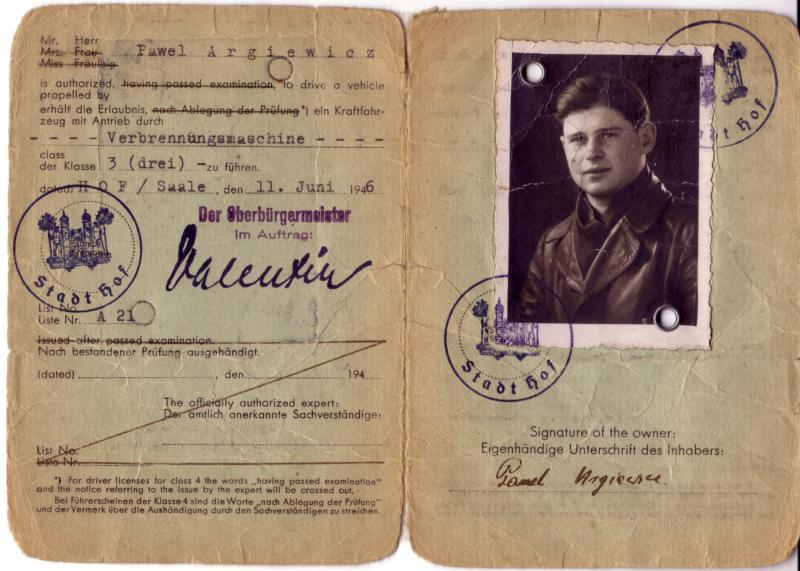
German Drivers License issued to Paul Angiewicz in June 1946. He was obviously living in Germany at the time and looking prosperous.
The same craving for attention also accounts for his willingness to falsely identify himself in the Famous Buchenwald Liberation Photo. Argiewicz named himself as the person 3rd from the left in the 3rd bunk up from the bottom in 2008, the same year his book came out. Everyone in that photo is self-identified, and it began after Elie Wiesel identified himself in it in 1983. Before that, no one was identified. After research by a number of people, including myself, it turns out the only correctly identified person is 16-year old Michael (Nikolaus) Grüner in the lower left. Even Argiewicz’ nephew, Murray Matzner, says his uncle is not in the picture, but excuses his uncle’s lies with the charge that he was under the influence of the woman who wrote the book about him, Deanne I. Joseph. Matzner wrote a comment at Scrapbookpages Blog in 2015 to a post that originally appeared in 2010.
It is obvious that my uncle Paul Argiewicz is not the person indicated in the photo. It looks nothing like him, and is in fact proved not to be him in his own memoir book photo on the opposite page where a drivers license photo one year later does not resemble this face at all. In particular, he did not have eyebrows that curved so far around his eyes.
The assertion that he is present in this photo was nonexistent until 2008, the year his memoir book was published. Since his ghost written book gets so very many facts and stories wrong, as the website associated with book sales also does, and stains a courageous man of integrity who is greatly missed because he is no longer with us, it appears that the false assertion is associated with the factually compromised book.
I have also seen a photo where it is the man one bunk lower, and to the left, a sleeping man facing away from the camera, who is indicated as my uncle with a vertical arrow.
I don’t know what it is with this photo. The individual indicated as Mr. Wiesel appears to have a receding hairline although a published image of him at age 15 prior to deportation does not have such a hairline. I believe that neither he or my uncle appear in the photo, and it appears to me that at least in the case of my uncle, that it was someone else pushing for him to be present.
My uncle was a wonderful, warm, caring, courageous, person who inspired so many with his exceptional love of life and people… but he isn’t in this photograph.
RIP, uncle. Your love lives on.
Comment by Murray Matzner — April 3, 2015 @ 1:03 pm
Okay Murray, except that Paul was photographed at one of his gatherings holding an enlargement of the famous photograph, indicating that he certainly wanted people to believe that he was in the picture. He, and maybe more so his wife Sheryl have been fully engaged in that fantasy.
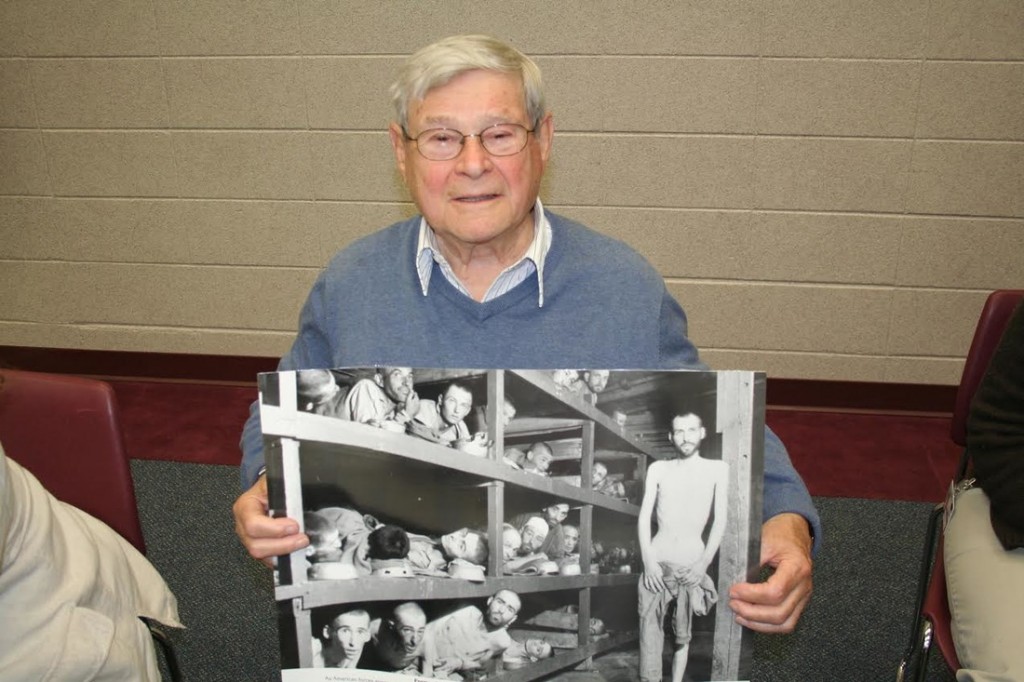
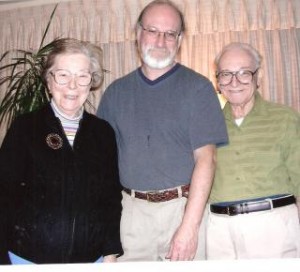
Lucy Argiewicz Matzner (Paul’s “beloved” sister), her son Murray and husband Robert.
Murray’s father, Robert Matzner, (left, in green shirt) who married Paul’s sister Lucy, was born in 1926 in the same Polish town of Bielsko. He has written his own holocaust memoir, titled Prisoner 19053. I wonder how many falsehoods that book contains? Hopefully not as many as Paul’s. But I think Murray may be trying to keep peace in the family by blaming the falsehoods in Paul’s book on the author. Clearly, Paul’s wife Sheryl had a lot to do with the writing of the book, and the three are often pictured attending book-promotion meetings together.
* * *
After Paul’s death in December 2013, some controversy broke out on the Amazon book advertisement page among the “reviewers.” Specifically “BTI” wrote:
In Memory of Paul
By BTI on June 22, 2015
Every story in this book is documented in numerous recordings, CDs, and videos as coming from Paul Argiewicz himself – his face, his words, his voice. It is Paul’s account of what happened to him as a young boy in the Nazi concentration camps. Anyone who knew Paul, loved Paul, was inspired by Paul, and truly desires to protect the memory of Paul Argiewicz will boldly stand witness against the frauds of the world (be they Holocaust deniers, anti-Semites, or vindictive relatives). All of the above-mentioned records of Paul’s testimony will soon be posted online. Be watching. May the evil ones be silenced by their own arrogance.
Cindy Nicoletti, Paul’s stepdaughter, posted a “review” by Dave Kasiske. In it he revealed:
“I am blown away that Paul’s nephew would come out now after Paul’s death. He cannot say the man in the picture is not Paul because the poor young Paul was probably close to death after experiencing starvation. Paul would say “Dave”, I can’t explain it to you how it was to cry at night because of starvation and never seeing my loved ones again.”
And
“Paul was always in tears when he told the story of his sister Lucy. Lucy is the mother of “Murray”, the one who is attacking Paul’s story. That brings the question to my mind, why would anyone who is Jewish go on a antisemitic spur? Even when I would sit with Paul at his kitchen table, the tears would flow when he talked about Lucy. Anyone who has the guts to attack a family member who survived the horrors of the Holocaust should seek psychological help.”
Yes, it takes guts indeed to stand up against holocaust lies, Dave. Maybe someday you’ll be able to do it. But now take a look at this from stepdaughter Cindy to see who is pushing Paul’s false story.
The owner of Sunless Expressions would like to recommend her stepfather’s book:
Number 176520
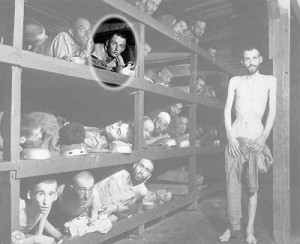
This famous photograph was taken a few days after the liberation of Buchenwald and appeared on the cover of a popular national magazine in the 1960s. Paul is pictured (circled) here on the third bunk from the bottom, the third person from the left (with his food bowl that doubled as a pillow).
Cindy, Owner and Founder of Sunless Expressions is the step daughter of a man with an astounding and miraculous life story. Paul Argiewicz was an eleven year old child in 1941 when he was arrested in Poland by two Nazi SS officers. His crime? Paul had stolen two loaves of bread to take to his starving family in the Jewish ghetto. Separated from his family and everything he loved, he would spend the next four years of his young life working as a slave laborer in seven different concentration camps. From Auschwitz to Blechhammer, Gross Rosen, and Buchenwald, Argiewicz; defied all odds by surviving one of modern history’s most unimaginable atrocities against humanity: the Holocaust.
Sunless Expressions is proud to recommend Number 176520 ~ The Story of Paul Argiewicz, a Teenage Holocaust Survivor. With over 16 pages of full-color photos, original camp documents, and other visuals, Number 176520 has quickly become a highly revered and sought-after Holocaust resource in schools, bookstores, libraries, museums, and homes. Visit www.paulsstory.com to purchase and/or learn more about the book that has been inspiring countless readers around the world.
We regretfully announce Paul passed away December 11, 2013.
Paul’s last public appearance before his death was on April 29, 2013 at the U.S. Holocaust Museum’s 20th Anniversary Ceremony with speakers Elie Wiesel and Bill Clinton. Here he is photographed with his wife Sheryl and grandson Jordan, who are active in furthering the mythical version of his life. In another photo he is showing off his Auschwitz tattoo “176520,” as they were all doing that night (except for Wiesel, of course). Yes, they were there, but what they did or did not experience cannot be proven by a tattoo.
There are no excerpts available from his book at Amazon, but I found this one and am going to quote it in full here. It gives a good idea of the fictional style found in most holocaust survivor stories – no dates, times, names – the events, as they are, exist as if floating in space, but are meant to evoke as much emotional sympathy, shock and pity as possible toward the subject. Notice the similarities to Elie Wiesel’s Night, which must have been used as a model, for example when the fellow arrestee advises a confused Paul to say he is 18. However, Paul’s “ghostwriter” handled the impossible jump from age 11 to age 18 by having the SS man play it as a sort of joke. And since Paul says he spoke perfect German, that warmed the heart of the otherwise cold officer. The whole scene is a lie …
At Scrapbookpages Blog, the blogger wrote in March 2010: “Argiewicz says that he had an advantage because he could speak fluent German since his mother was from Bavaria, a state in Germany.” Of course, we know his mother and father were both Polish, and Ms. Joseph comes up with a different story: That Paul associated with Gentile youths when he snuck out of the ghetto every other night for a year (!) and learned German that way. But weren’t there Poles along with Germans outside of the ghetto? This is not explained, of course, but left to your imagination. Apparently a German baker and his children just loved little Paul and gave him bread and German lessons too.
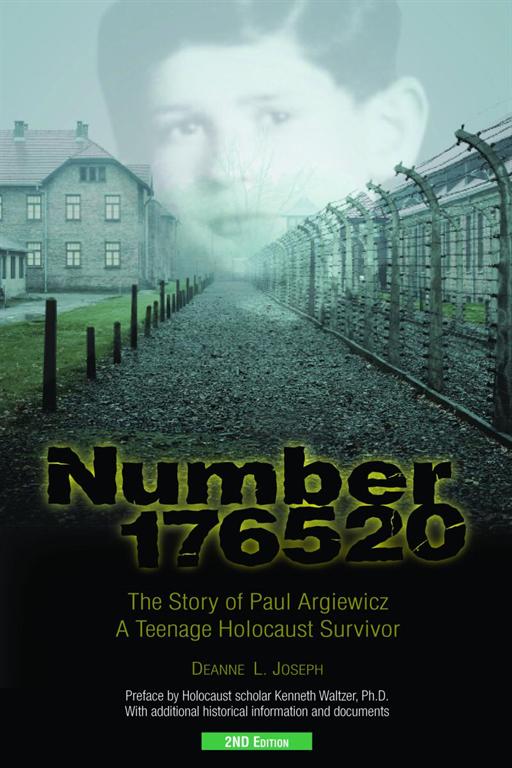
Look how dishonest the book cover is. Paul was not a young child in the camps but 16 to 19 years old. He wasn’t even in Auschwitz except for 2 days, then, according to him, sent to Blechhammer, and spent the last 4 months at Buchenwald.
The preface to the book is written by our old friend, Professor Kenneth Waltzer, and in it he gives “historical documentation.” I would really like to see that. I should order the book and write more about this later; the only thing that stops me is that you and I both know there is no end to this stuff. One thing leads to another. So we’ll see, but for now, enjoy this excerpt. You will notice that not a single person has a name except Paul.
* * *
Deanne L. Joseph’s moving new memoir, Number 176520 –The Story of Paul Argiewicz, a Teenage Holocaust Survivor, poignantly recounts one child’s journey through the terrors. With a preface and historical documentation provided by renowned Holocaust scholar, Professor Kenneth Waltzer (Director of Jewish Studies, Michigan State University), Number 176520 is quickly becoming an invaluable resource for students of the Holocaust.
Following is an excerpt from the book:
Paul and his family lived in the ghetto for about a year. In spite of the dire circumstances, his boyish, adventurous nature remained. He removed the identification patch from his clothing and sneaked out of the ghetto [Sosnowiec, not Warsaw -cy] through an opening in the barbed wire fence. It was an act of defiance that would have landed him at the end of an executioner’s gun had he been caught, but somehow he was able to pull off this rite two to three times a week. [I don’t think an 11-year old boy would be allowed out alone at night by his loving parents, do you? Neither would he have been shot dead if caught.-cy]
Being the gregarious child that he was, he made friends with some gentile children on the “outside.” They did not seem to mind that he was Jewish, and some of their parents even tried to help him in small ways. The father of one of his new friends owned a bakery. The man’s sympathetic conscience obliged him to turn a blind eye, allowing Paul to steal freshly baked bread from his store twice a week. The ritual continued for a year. Sometimes the determined young scavenger managed to find potato peels or other small provisions of vegetables and was always faithful to rush his smuggled goods back to his hungry family behind the fence.
Eventually, Paul became so comfortable in his excursions that he inadvertently lowered his guard and came face to face with disaster. Returning to his family with a pair of stolen loaves of bread, he was approached by two SS officers.
“Where did you get that bread?” they demanded. Paul had never been so close to the enemy. He stood, accused and frozen.
“Come with us!” The order was stern and curt. They snatched the bread from his hands. The pounding of his heart intensified until he thought it would surely break through his chest. He could barely breathe. He felt a hard, squeezing pressure on his arm — the grip of a Nazi. He had the sensation of walking very quickly, although he was unable to feel his legs. Were his feet touching the ground? Were they even moving? He heard only the sound of the officers’ boots clacking with each step on the hard street beneath their feet. His eyes burned as if on fire, and blurred images of his family flashed through his rattled brain. What would they think? Would he ever see them again? Were these men going to kill him? Paul fought to restrain the tears pooling in his eyes. He was only a child — his life was supposed to be ahead of him, not behind.
They arrived at their destination: an old schoolhouse that had been converted into a transitory evaluation and detainment center, the Durkankslager. He was taken downstairs to the basement, the “dungeon.” It was filled with people standing in lines. Everywhere were the familiar Jewish identification patches. The Nazis pushed him into place with the others. He looked around at the detainees, predominantly grown men. He did not see any other children in the crowded space.
An SS officer sat upright on a stool at the front of the room, one leg raised and bent at the knee with his booted foot confidently perched on a table. Behind him was a desk filled with papers. As each of the accused men made his way to the front of the line, he was questioned by the man on the stool, evaluated, and sent into a group either to the right or to the left. Paul was not sure why the men were being divided, but as he drew closer to the evaluating officer, he was overcome with a sense of doom. His mind fired rapid, disconnected thoughts. I’m only a child . . . perhaps if I tell them I’m only 11 years old . . . maybe they will have pity and let me go back to my parents.
Without warning, a man behind him in the line kicked the back of his leg. He leaned into Paul’s ear and spoke quietly but firmly.
“Don’t tell them your real age. Tell them you’re 18.”
How did he know what I was thinking? Paul wondered.
He arrived at the head of the line. No longer did anyone stand between him and the “judge.”
“Name?” “Paul Argiewicz.”“Age?” “Eighteen.”
The words rolled off his lips in perfect Bavarian German. The officer looked up. His dusky eyes examined the youth before him. His brow furrowed, and he observed the boy for a moment. Paul felt as though he had been suspended in space and time. The moment seemed to last an eternity. Surely, he was exposed . . . guilty . . . he had lied . . . to an SS officer! The penalty for such an offense was execution.
“You speak German?” The officer seemed amused. “Yes,” he responded once more in the language he had learned from his playmates.
“You speak with a Bavarian accent. Why?” “My mother is from Bavaria,” he lied again. For another endless moment, the man’s eyes pierced him. Paul was able to manage a convincing expression. Finally, the harshness of the Nazi’s sharply featured face faded, yielding to a smile and a chuckle.
“Go over there,” he said, nodding his head to his left.
Paul moved in the direction of the nod, but he did not understand the purpose of separating the men. Would he be sent to work or to the grave? None of the men seemed to know the fate that awaited them.
They remained in the detainment center for a few more days. Each day they were given small rations of bread and a cup of water. Paul allowed his mind to escape into a place of refuge and peace. He comforted himself with thoughts of his family, memories of good times they had shared, life in Phella’s beautiful home, and the hope that maybe he would soon be returning there.
In the corner of his eye, Paul perceived movement through a window in the damp stone wall. He turned his head to look through the dusty glass. Just beyond the tall barbed-wire fence, his father stood, his eyes scouring the room through the wire and glass. Noah’s eyes found Paul’s. His hand flew over his head waving to his son, his familiar penetrating eyes filled with longing. He held his hand still for a moment and then let it fall limp to his side. He stood motionless, his gaze fixed on his child. [This is a totally fictional account intended to create poignancy. Paul never saw his father through a window.]
Paul’s heart raced within him. An overwhelming urge demanded that he jump to his feet and run to the window. He dared not. To do so would jeopardize not only his fate but also now his father’s. Separated by brick and mortar, barbed wire and guns, and the merciless cruelty of the human heart, father and son looked upon each other for the last time. In that sacred moment, they knew that the bond they shared was beyond man’s reach; it was a bond protected and preserved in eternity. Still, the 11-year-old was overcome by the realization that he might never again feel the loving touch of his father’s strong hands or hear the sound of his voice.
On the cold, hard floor, Paul covered his face and wept. His father was gone. [End of excerpt]
5 Comments
Category Featured | Tags: Tags: Auschwitz tattoos, famous Buchenwald photo, Holocaust fraud, Ken Waltzer, Murray Matzner, USHMM,
Social Networks: Facebook, Twitter, Google Bookmarks, del.icio.us, StumbleUpon, Digg, Reddit, Posterous.
Tuesday, March 22nd, 2016

U.S. Sen. Ted Cruz (R-Tex.) listens to Elie Wiesel at a Senate roundtable discussion last year. Cruz said the nuclear talks with Iran were reminiscent of Western appeasement of Hitler. (Say again??)
By Carolyn Yeager
Currently running for the Republican nomination for President of the United States, Cruz spoke on Monday, March 21 to the annual American-Israel Public Affairs Committee, Washington’s largest lobbying group and an unregistered agent of the Israeli government in the U.S.
His words were described as being those he has spoken many times before, but naturally what stood out to me was what he said about Elie Wiesel. At 13:40 into his speech he said:
A year ago, I was honored to join the great Elie Wiesel on a panel discussion in the Senate about this disastrous Iranian deal. Not a single democrat was willing to join Elie Wiesel … to sit alongside someone who witnessed first hand the horrors of the “Holocaust,” who brings a moral weight and gravity second to none, was both powerful and humbling. And I am convinced, after this election, the American people will stand and say together “Never Again” means never again.
On my very first day in office I will begin the process of moving the American Embassy in Israel to Jerusalem, the once and eternal capital of Israel.
Does Texas senator Ted Cruz know anything at all about what is called the “Holocaust?” Does he know anything at all about Elie Wiesel’s life? No, to both. I am sure he has never read a single book by Elie Wiesel, yet he calls him “the great” based on the fact that Wiesel was awarded the Congressional Medal of Honor by the same ignorant Congress of which he is a part. This man Cruz is a complete panderer who accepts whatever the Jewish power structure says and bows low hoping to be selected to do its bidding.
And what does he mean by “After this election, the American people will say “Never Again” means never again.” Does he mean the “Holocaust” will be more dominating than ever? And Jews will be protected like never before? Just the direction we should not go in.
Cruz goes on to say at 15:08:
And as president, I will do everything in my power to ensure that anyone who provides financial support to the BDS movement, including schools and universities, will lose any access to federal funding. And to the extent they have engaged in any illegal behavior, they will be prosecuted to the fullest extent of the law.
BDS stands for Boycott, Divestment and Sanctions – a global campaign to increase pressure on Israel to end its occupation of Palestinian land. Israel is clearly the immoral party in this situation, yet Cruz cares not for morality, even as he holds himself up as an evangelical Christian following the teachings of his Cuban father’s rather extreme Christian cult. In reality, Cruz is an Old Testament Christian – in other words, a Jew. A man who feels honored to sit next to one of the most obnoxious liars of the 20th Century (and into the 21st), Elie Wiesel, author of the entirely false testimony, Night.
For these reasons, I want to make it known that I will never, under any circumstances, vote for Senator Ted Cruz for anything. Should he somehow become the Republican nominee, I will choose not vote, and will sit out the election in disgust.
1 Comment
Category Featured | Tags: Tags: AIPAC, BDS Movement, Elie Wiesel, Jerusalem,
Social Networks: Facebook, Twitter, Google Bookmarks, del.icio.us, StumbleUpon, Digg, Reddit, Posterous.
Saturday, March 19th, 2016
BY CHRISTINE MILLER
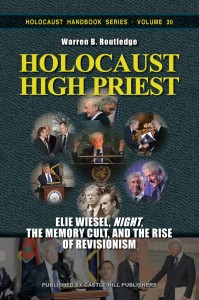
Holocaust High Priest by Warren B. Routledge, published in 2015.
I ACQUIRED THREE COPIES of Holocaust High Priest: Elie Wiesel, Night, the Memory Cult and the Rise of Revisionism, by Warren B. Routledge. I intend to give one copy to the Marshfield (Wisconsin) Public Library (if they accept), the other copy to Stratford Public Library and one is for myself. I was very interested in what the author, Warren B. Routledge, has to say about Elie Wiesel’s book Night, since I also challenged Night on December 1, 1997. At that time I was still a busy teacher, housewife and mother without sufficient time, nor do I have the meticulousness nor the inclination to be as thorough as Routledge. Neither was I ever at Auschwitz, therefore could not cite the mistakes which Routledge points out that Elie had made in describing the location.
Mr. Routledge has also done meticulous research on dates which are inconsistent. My earlier challenge kept to what to me were obvious absurdities which Routledge has neglected or overlooked. Thus it may be worthwhile to review my challenge.
An appeal to reason
December 1, 1997
Dear Members of the Board:
When Mr. Markwardt, head of Marshfield Public School Libraries, wrote (June 3, 1997): “The German people should suffer a shared guilt that should last many generations,” he invigorated my resolve to fight the gas chamber-holocaust lie. The next generation are my children. Does he and his fellow travelers in spirit really think that I would sit back while they press the mark of Cain on my children’s foreheads? I hereby request that the Marshfield school libraries eliminate “Night” by Elie Wiesel. 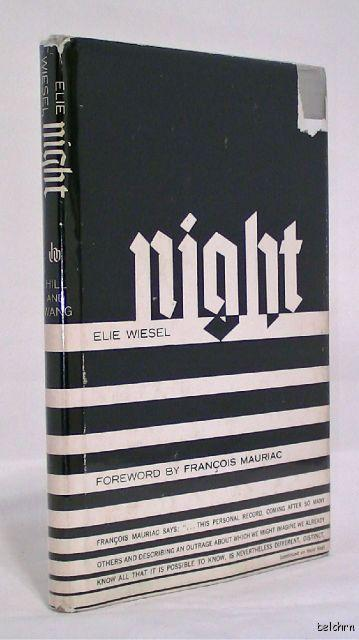
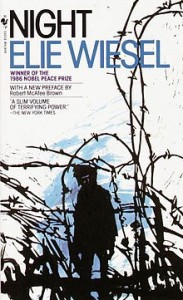
This is the original “Night” paperback from which the quotes in this article were taken.
“Night” is like a Monte Python skit with this difference. In a Monte Python skit the absurdities are funny. In “Night” the absurdities are pernicious and meant to indoctrinate our children with hate.
There is the Pythonesque episode of the baby toss. “Babies were thrown into the air and the machine gunners used them as targets.” – Machine guns are not used for target practice , but for sweeping a wide field from side to side.
There is the Pythonesque episode of a wildly shooting Gestapo who, instead of shooting at the neck, shot Moshe the Beadle in the leg. “Each one (Jew) had to present his neck … How had Moshe the Beadle escaped? Miraculously. He was wounded in the leg and taken for dead …” – This really must have been a miracle in the truest sense of the word.
There is the Pythonesque episode of the copulating youngsters in an overcrowded train. However, there is one difference. In the skit, only cartoon characters are made to copulate. “Free from all social constraints young people gave way openly to instinct, taking advantage of the darkness to copulate in our midst.” – Our high school students are very liberated, but I cannot imagine any of our sweetheart couples copulating in a train so crowded that the act would have to be performed standing up. Much less can it be imagined of these Jewish youngsters brought up within a society of strict sexual morality, a society which did not condone dating but still relied on matchmakers. I think Elie has a dirty mind.
There is the Pythonesque episode of Juliek playing his violin in a space so crowded that the dead were heaped upon the living. Elie Wiesel asks: “How had he (Juliek) managed to free himself?” – My question is: How had Juliek managed to get his fiddle out uncrushed, and how was he able to move his fiddle arm in order to play from a Beethoven concerto when at the same time Elie was crushed underneath bodies and had to battle for a mouthful of air? The next morning Elie found Juliek asphyxiated by the crush of people. I am not impressed with the reasoning prowess of most people. But nevertheless we expect a certain amount of reasoning and logic from adults which we do not expect from children. Children are therefore extremely vulnerable to atrocity propaganda. If you leave this book in our school libraries you are not doing right by our kids.
Sincerely yours,
Chris Miller
An appendix:
After that challenge I came across another book by Elie Wiesel: “Tous Les Fleuves Vont a Mer – All Rivers Run to the Sea – Memories.” In a long paragraph which I had to shorten (herewith my translation), Elie has this to say. (The whole paragraph has been expunged from the English translation: “All Rivers Run to the Sea,” Schocken Books, New York.)
“That trip in the train, I described it in my first testimony, needs clarification – and it is delicate. It deals with the erotic atmosphere which prevailed in the train. In the French version I say: ‘Freed from all social constraints, the young people gave way open to instinct, taking advantage of the darkness to copulate in our midst.’ [page 20, original Night] Then I rechecked the original version in Yiddish. There the passage reads differently … It describes the timid contacts which never exceeded the bounds of decency. [Not true – it is the same in Yiddish! -cy] How could I have translated that with: copulate? I do not know. … Perhaps I was speaking of myself. … For the first time in my life I could touch a woman. …
“The rest belongs into the realm of phantasy.”
Not only is this episode a case of Elie Wiesel’s phantasy, his whole story is. Routledge wonders if Wiesel ever had set foot into Auschwitz. After rereading “Night” I wonder about that too. “But we had been marching for only a few moments when we saw the barbed wire of another camp. An iron door with this inscription over it: “Work is liberty” (work is freedom)! Auschwitz.” [page 37, original Night]
My comment: Nowadays everybody seems to be familiar with the entrance gate (it is a gate, not a door) with the inscription: “Arbeit macht frei” (work sets you free).
“Work is liberty” is Orwellian like “War is Peace.” How could Elie have made that mistake? I attempt an answer. The French original of “Night” was copyrighted in 1958. During that time neither Auschwitz, Treblinka nor Sobibor were in the news. We Germans were still hammered with the gas chambers at Dachau, Bergen-Belsen and Buchenwald. But slowly a shift took place. The gas chamber stories in the camps on German soil could no longer be maintained. The camps inaccessible behind the iron curtain took their place as extermination camps. Elie Wiesel wrote “Night” before that shift had taken place and was therefore not familiar with the inscription.
Elie was deported at the age of 14. He claims to have had a golden crown in his mouth which everybody coveted, especially the foreman, Franek. A dentist finally broke it out with a rusty spoon. Mengele, whom Elie saw wearing a monocle, and Elie as a fourteen year old having a gold crown are metachronisms (meta, after + chronos, time), chronological errors. As the people of Marshfield don’t drive to Stratford anymore in a stagecoach, in 1940 nobody wore a monocle and a kid did not get a golden crown. A child had his tooth yanked, and only if he was lucky by a dentist. I also do not know how you can get a crown out with a spoon. Needless to say, with Elie, the spoon had to be rusty. [page 50-51, original Night]
After I had written my challenge I got the German translation, “Die Nacht.” In the preface it reads that: Elie Wiesel with his parents and younger sister were deported to Auschwitz. Only later on does the book talk about sisters who remain nameless. (These two sisters were hale and hearty after Auschwitz was taken by the Russians. His younger sister and his mother died most likely in a typhus epidemic). [That is, if they were ever there, and Mrs. Miller does question whether Elie was. -cy]
In the English translation there are no gas chambers. “When he (Bela Katz) heard of our arrival, he managed to get word to us that, having been chosen for his strength, he himself put his father’s body into the crematory oven.” In the German translation it reads: “Als er von unserer Ankunft erfuhr, liess er uns sagen, dass er wegen seiner Koeperkraft dem Sonderkommando zugeteilt und dadurch gezwungen worden sei, seinen eigenen Vater in die Gaskammer zu schieben.” In the German translation “Nacht”, all the crematory ovens of “Night” are turned into gas chambers. Western man has been made irrational. That was a necessity, otherwise he could not have been made to believe in the absurdities of the Holocaust lore.
In case you are interested:
March 6, 1998
Christine B. Miller
606 Cypress Avenue
Marshfield, WI 54449
Their reply
Re: Decision of Reconsideration Committee on February 12, 1998
This is to inform you that the Materials Reconsideration Committee of the School District of Marshfield voted to retain the book “Night” by Elie Wiesel on the shelves of the Library Media Center in the Junior High School.
You may contact me if further information is needed.
Sincerely,
Ken Krahn
Superintendent of Schools
~~
Christine B. Miller was born in Bavaria in 1935 and lived through the National Socialist regime and the 2nd world war as a child on her grandparent’s farm. She emigrated to the United States in 1956, went to college, married, raised a family and became a high school German teacher in Marshfield, WI. She has published two books: Reality Check and Feldzug im Osten (Campaign in the East). She was interviewed on The Heretics’ Hour in 2011 and 2012.
This essay first appeared in The First Freedom, March 2016.
2 Comments
Category Featured | Tags: Tags: Christine Miller, Holocaust High Priest, Marshfield Public School Libraries, Night, Warren Routledge,
Social Networks: Facebook, Twitter, Google Bookmarks, del.icio.us, StumbleUpon, Digg, Reddit, Posterous.
Saturday, March 5th, 2016
Followup of “Elie admits he doesn’t have the tattoo A7713”
By Carolyn Yeager
copyright 2016 Carolyn Yeager
![Elie Wiesel's left arm in bright sunlight in a still from his own video "Elie Wiesel Goes Home" - no retouching. [courtesy Eric Hunt]](https://www.eliewieseltattoo.com/wp-content/uploads/2012/01/EW_arm-no-tattoo1-e1450887466391.jpg)
Elie Wiesel’s left arm in bright sunlight in a still grabbed from his own movie “Elie Wiesel Goes Home” – no retouching possible. [courtesy Eric Hunt]
Turns out? How long do we wait for something to “turn out?”
Wiesel will be 88-years-old on September 30th of this year. Very few human bodies are able to carry on after their 90th year, so, without a consensus opinion from the revisionist community, we are looking at the prospect of an eternal “We’ll never know” pasted over the Elie Wiesel tattoo question. Naturally, this is what Wiesel supporters want, but should revisionists be content with never going beyond that, continuing to fear there will come a time he will dramatically pull up his sleeve for the cameras?
He’s already done so and we have the result in the image at right.
And what don’t people understand about logic? One doesn’t need a University course in logic to use common sense. Two plus two adds up to four – we don’t need a calculator to prove it, our fingers can tell us. What should we think of those who would say “But what if it doesn’t? What if our fingers turn out to be wrong?”
It’s the same logic we use when someone tells us he has a number tattooed on his arm that proves he was at Auschwitz in 1944 – we expect it to be shown to us. There is no reason we should have to take it on trust. Imagine yourself in a real life situation like that and you’ll get it. Those who are willing to accept a deal such as we have in the case of Elie Wiesel are either cowards, frightened serfs, or collaborators in the lie. But people are also ignorant of the facts – even though mostly through choice, and maybe also poor memory.
For this reason, I want to specifically address these persons to try to give them a little backbone … er, I mean background. You need to be clear about how Elie Wiesel got into this tattoo quandary to begin with.
To those whose reasoning goes, Why would Wiesel say he has a tattoo when he doesn’t have one? He wouldn’t be so foolish, therefore I have to assume he might have one. He also doesn’t need to have a tattoo to have been at Auschwitz, – they forget about the Yiddish book, Un di Velt hot gesvign (And the world remained silent), from which Night was taken. In that book, and carried over to Night, Eliezer and his father were tattooed on their left forearms with A7713 and A7712. It follows that if Night is Elie Wiesel’s own story, he has to have a tattoo.
On page 51, the author wrote:
The three “veterans,” with needles in their hands, engraved a number on our left arms. I became A-7713.
Now I hope you understand (and please don’t forget it again) why he has to have that particular tattoo, and why he has always said he does have it. He has no choice. The fact that it has never been shown to the public speaks volumes (never underestimate his belief in his ability to fool the public), as well as the fact that we’ve seen his uncovered left arm in photographs and there is no such number there. What more proof do you want? The final nail in the coffin is that Wiesel and the people around him remain silent about it – they will not allow the question to be asked. That is the “admitting” part.
So it’s settled – Wiesel has no tattoo, and he admits as much. He’s kept up the lying charade so long because he could! No one challenged him. Once again, I will give credit to Jew Michael Grüner for breaking this open, even though he makes up plenty of ridiculous concentration camp stories himself. But Grüner got the documents and made them public, along with explanatory letters from Auschwitz and Buchenwald.
If Wiesel is not a concentration camp survivor, we need to look into other possibilities for his whereabouts in 1944. We will not be able to prove anything – this period of time could not be more confused. Displaced persons and self-identified camp survivors were flocking into Western Europe in search of opportunities; they were creating new identities and applying to go to Israel and to America. In all of this, it’s impossible to find any kind of a trail. But some pathways are more plausible than others for the Wiesel family.
Wiesel’s family is not found in records at Auschwitz
Speaking of documents, do you know there is no record of any member of Wiesel’s immediate family at Auschwitz? That’s a fact. In addition, the only record, as far as I know, of Elie’s two older sisters being at the Dachau sub-camp Kaufering comes from a book put out by the “Central Committee of Jews in Bavaria” in 1946. They published a list of 61,387 Jews in a book named Sharit Ha-Platah (translates as “Counted Remnant”), among which are listed Hilda and Bea Wiesel. The names were collected by Chaplain (Rabbi) Abraham Klausner, who is said to have visited many of the camps in southern Germany where survivors gathered in late 1945 and 1946. You better believe the Rabbi wanted to get as many names as possible, and that there is nothing official about this list.
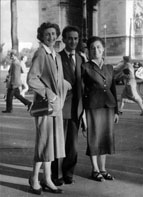
Bea, Elie and Hilda Wiesel in Paris after the war.
We first meet up with Hilda and Bea as refugees in Germany, just as we first meet up with Elie at a Jewish orphanage in France. Hilda Wiesel married an Algerian Jew and moved with him to Paris. She has since spoken about her family’s deportation in a Shoah Foundation videotaped interview, but without details of what happened after they arrived at Auschwitz. Her sister Batya (Bea) emigrated to Canada and never spoke publicly about it at all.
Hilda’s Shoah Foundation testimony which she gave in 1995 (coincidentally the same year Elie’s official autobiography All Rivers Run to the Sea came out) differs from her brother’s story in Night in numerous details. Relevant here, she said:
We were deported on 15 May [1944]. We heard around 1943, because we had family in Belgium, we heard that they had deported a cousin, but we didn’t know where to …
I can only tell you one thing, that the third transport – we had to stand 5 by 5, five abreast – there were Hungarian gendarmes, hardly any Germans, mostly Hungarian gendarmes.
We were myself and my sister, the one who was in Canada and is now deceased; my mother; my grandmother, that is my father’s mother; and, oh … my little 10-year old sister. And we arrive in Auschwitz, the men were apart, my father with my brother.
According to the original Night and the Yiddish And the world remained silent, the family’s deportation date was June 3, 1944. In Marion Wiesel’s re-translation, it was changed to May 20. So which is correct? Most likely none.
Hilda also tells us the women and men traveled in separate cars.
My mother knew there was no hope, because she told me and my sister, always stay together, always stay together. And she said, go tell your dad to always stay together with Elie. And I ran over to him and said, Papa, stay with Elie, stay with him – like that.
Q: This was on the train, that you are describing?
A: No, it was after getting off the train.
If they were in the same train car, Mother could have told her husband herself. But Night and its Yiddish precursor describe the boys and girls having sex together in the darkness of the train, freed from following the usual rules, and Wiesel says he was traveling with his mother and sister — everyone was together. Let me make clear that I don’t have any more faith in 70-year old Hilda Wiesel Kudler’s testimony than I do Elie Wiesel’s “stream-of-consciousness” autobiography, which, as I said, coincidentally appeared at the same time in 1995. And I am not convinced by this that the family really went to Auschwitz since not one of them was registered there, nor do their names come up on any hygiene or other reports even though they were supposedly put in quarantine. We do find Lazar and Abraham Wiesel, and Myklos Grüner, his father and brother listed on a hygiene report.
I’ll also add that Mother, Grandmother and youngest sister [10 years-old according to Hilda Wiesel, but 7 years-old according to Elie in Night, where Grandmother is not included] are understood to have been sent directly to the “gas chamber” and gone up in smoke through the chimney shortly thereafter. Since homicidal gas chambers didn’t exist, all the women would have been sent to the showers, gone through the disinfection process, given new clothing and assigned to a women’s barrack, the same as Wiesel writes about Eliezer and Father. However, a grandmother and mother with a child would have been assigned to non-working barracks; the two 20-somethings to barracks for female workers.
A very odd fact is that both in Night and in the Yiddish book, Eliezer and Father never mention their wife, daughters, mothers and sisters again. They don’t look for them, talk or ask about them, as other people did. They apparently accept being told that their loved ones “went up the chimney” and immediately become concerned only for themselves. I don’t believe this; it’s not human nature, it’s make-believe.
So if not there, where else could the Wiesel family have been in 1944?
Following a trail of possibilities
Well, we do have Shlomo and Mendel Wiesel’s first cousin Yaakov Fishkowitz filling out a Yad Vashem Page of Testimony for each of them, reporting they both died in 1943 in a “labor camp.” If Yaakov didn’t believe this were true, why would he have done this in 1957 at the same time he filled out other pages for relatives he marked as being sent to Auschwitz in 1944? He also said Shlomo was born in 1903 and Mendel in 1905.
Add to this the very weak story Elie Wiesel gives for why his family didn’t do something to protect themselves from the “Nazi menace.” On page 8 of Night, Wiesel wrote:
In those days it was still possible to buy emigration certificates to Palestine. I had asked my father to sell everything, to liquidate everything, and to leave. ‘I am too old, my son,’ he answered. ‘Too old to start a new life. Too old to start from scratch in some distant land …’
Too old at the age of 41? Fishkowitz puts his birth in 1903. Other than that, there is no official birth date for Elie Wiesel’s father. In a close family, children always know their parents’ age and birthday. Hilda said her mother was born in 1900. So Shlomo Wiesel’s age is being covered up by son Elie, who left blank the DoB space on the Page of Testimony he filled out for his father. We can say that the oldest Shlomo could have been was 48, but more likely younger. Wiesel has always made his father out to be a tired old man, especially in Night. I have distrusted this characterization and believe it was a literary device to make the story more poignant, just like turning 10 year-old Tsipora into a 7 year-old.
The following interesting passage is on page 27 of the Yiddish Un di Velt hot gesvign, but is not included in the shorter French or English Night:
We had opportunities and possibilities to hide with regular goyim and with prominent personalities. Many non-Jews from the surrounding villages had begged us, that we would come to them. There were bunkers available for us in villages or in the mountains. But we had cast aside all proposals. Why? Quite simple: the calendar showed April 1944 and we, the Jews of Sighet, still knew nothing about Treblinka, Buchenwald and Auschwitz.
Two things here. It again says it was April, not May, when the Sighet Jews first learned they would be deported. It confirms the passage on page 83 of the Yiddish book: “It was a beautiful April day,” said on one of their first days in Auschwitz-Birkenau.
The other thing – it is not true the Jews of Sighet knew nothing, yet that is what Wiesel writes in his autobiography All Rivers, while at the same time he also writes of Polish Jews passing through their neighborhoods telling stories of terrible atrocities by German occupiers. He says that non-Jews offered the Wiesel family places to stay. Wiesel writes that their Christian maid Maria begged them to come to her village and she would keep them safe. How many Jews may have taken advantage of such offers? But we’re told that Shlomo Wiesel refused to accept this kindness of Christians, and Elie’s only explanation is that they still didn’t believe the stories they were hearing. Then he blames the world for not warning them! This can be found in All Rivers Run to the Sea, on page 63 and 68-69.
Isn’t is possible the reason we find mention of these offers of help in all three Wiesel books is because it was such an important part of his experience that he felt compelled to include it? His family hid out and were protected from arrest. Or … maybe only he was sent away for safety, and his mother and sisters had different experiences. His father too, unless he did indeed die in 1943.
After the war, when only Elie and his two older sisters reunited, it was convenient to say the others were “murdered” in Auschwitz. That was the preferred story at the time. After all, with an advertised death toll of four million until 1990, there was plenty of room to say hundreds of your relatives were exterminated there.
In France
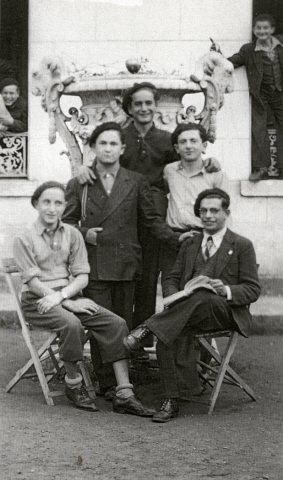
Elie Wiesel is center-top with a group of friends all wearing berets, at Ambloy, France in 1945.
Wiesel could have been sent to the home for Jewish orphans in France after the war from wherever he had been staying. In the few photographs we have, he looks cheerful and well-adjusted. He has friends, and seems to be a leader of younger boys. His hair is very long in the front, too long to have grown out from a concentration camp shaved head just a few months before.
From his very first year in France he was extremely interested in Zionism, the struggle in Palestine, and was a supporter of the Irgun, the Jewish terrorist organization in Palestine. Where did he learn all this, since he says that while in the camps he had no interest in anything. This is another reason to suspect he sat out the “Hungarian Holocaust” and was staying in a safe political environment somewhere.
I have written so many details in the various articles on this site that suggest or show outright that Wiesel has lied about many, many things – that he is faking it when it comes to so many aspects of his story. It’s not like he’s a paragon of truthfulness and I am therefore going out on a limb, or defaming him, by questioning the basics of his story. What really gives me a justification to do so comes back to – yes, that’s correct, his lack of a tattoo!
I think it shows that Wiesel and his friends know how damaging this tattoo business is by the fact they won’t speak about it – they completely refuse to deal with it. The Jewish Shoah believers in France at Enquete & Debat tried but could not get Wiesel to answer any questions about the tattoo by writing to him at his Foundation office in Romania. After a period of time they phoned there and Wiesel’s assistant hung up on them as soon as she realized what they were calling about. If holocaust-believing Jews are treated that way, it tells us just how unwelcome the topic is.
As I’ve said before, the only way to bring attention to Wiesel’s serious tattoo problem is to make a lot of noise about it – to get public attention on it. This is not happening and will not happen as long as the general response is: Forget the tattoo because it might turn out that he has one.
The cowardice in such a position leaves me flabbergasted. It’s half ignorance, as I said above, that is true, but the other half is lack of nerve. I am doing my best to dispel the ignorance. Those promoting the Wiesel legend lie, lie, lie, lie, lie and it doesn’t bother them in the least, while the truth forces are afraid of being wrong when the odds for being wrong on this are 5% or less – to me, it’s 0%. To continue to be content with just asking the question “Is it possible that Elie Wiesel doesn’t have the tattoo he said he does?” and fail to go beyond that to a declarative statement on the matter is not an acceptable outcome considering all we know.
It’s time to put all doubts aside and claim the obvious.
8 Comments
Category Featured | Tags: Tags: Auschwitz, Elie Wiesel, Hilda Wiesel, Night, Shlomo Wiesel, Un di Velt Hot Gesvign, Where's the Tattoo?,
Social Networks: Facebook, Twitter, Google Bookmarks, del.icio.us, StumbleUpon, Digg, Reddit, Posterous.


























![Elie Wiesel's left arm in bright sunlight in a still from his own video "Elie Wiesel Goes Home" - no retouching. [courtesy Eric Hunt]](https://www.eliewieseltattoo.com/wp-content/uploads/2012/01/EW_arm-no-tattoo1-e1450887466391.jpg)


